
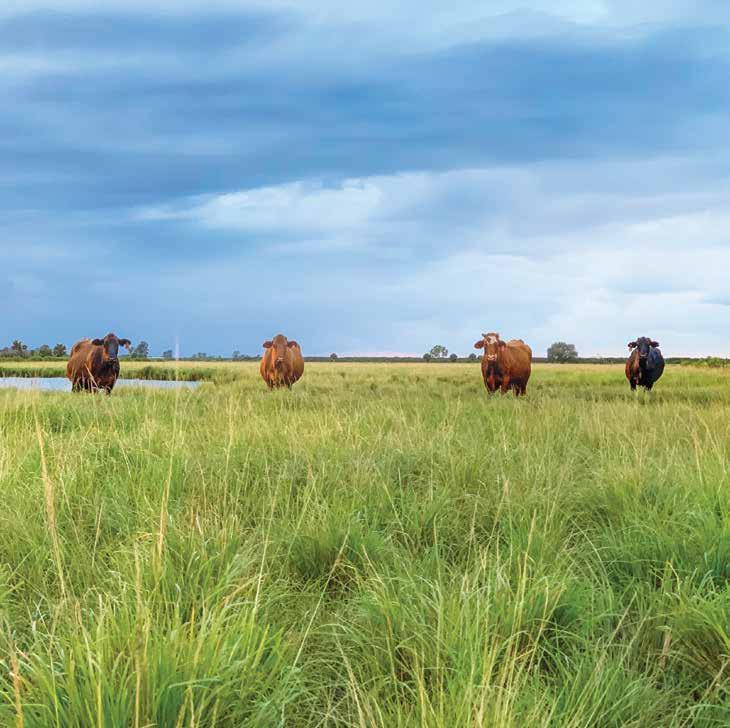
WWW.INTHEFIELDMAGAZINE.COM INTHEFIELD MAGAZINE December 2022 2 PAGE Cover More Ground with CKP Let CKP Help You Protect Your PRF Our PRF specialists are trained to help you analyze complicated insurance data so you: • Protect your land and livelihood against potential losses during times of drought. • Make the most informed decision for your business. Why now? • Very affordable – Government subsidized • Premiums are not due until October 1 • No adjusters needed • No claim forms • Protects your cash flow “Anyone can sell you a policy. But CKP invests the time to understand your individual needs and develop a strategy that will produce the best coverage results.” The USDA Risk Management Agency helps protect your Pasture, Rangeland, and Forage (PRF) from the elements. 877-CKP-INS1 ( 877-257-4671 ) ckpinsurance.com CONTACT YOUR CKP PRF SPECIALIST TODAY

WWW.INTHEFIELDMAGAZINE.COM INTHEFIELD MAGAZINE December 2022 3 PAGE
Polk County Cattlemen’s Association
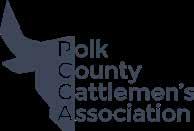
P.O. Box 9005 • Drawer HS03 Bartow, FL. 33831-9005
President – Kevin Fussell 4523 Fussell Rd Polk City, FL 33868-9676 (863) 412-5876
Vice President – Dr. Lujean Waters 8750 Shreck Rd Bartow, FL 33830 (863) 537-1495 Lujean.waters@gmail.com
Secretary/Treasurer - Justin Bunch PO Box 849 Highland City, FL 33846-0849 (863) 425-1121 justin.bunch@cpsagu.com
State Director – David Hunt 9699 Alt Bab Pk Cut-Off Rd Bartow, FL 33830 (863) 287-1835 Dhunt285@aol.com
Alternate SD – Orrin Webb PO Box 202 Bartow, FL 33831 (941) 916-5093 cwebbowebb@aol.com
Ray Clark 4484 Swindell Road Lakeland, FL 33810 (863) 640-0719 rclark@tampabay.rr.com
Donald Conroy 3882 Wolfolk Rd Fort Meade, FL 33841 (863) 412-0790
Stuart Fitzgerald PO Box 1437 Lake Wales, FL 33859 (863) 206-5021 stuartcattlellc@yahoo.com
Ken Sherrouse 13475 Moore Rd Lakeland, FL 33809-9755 (863) 698-1834 kensherrouse@yahoo.com
Scott Shoupe 6130 Allen Lane Lakeland, FL 33811 (863) 581-7593 Scott_shoupe@hotmail.com
James Stice
PO Box 460 Highland City, FL 33846 (813) 714-2333 jstice@verizon.net
Dave Tomkow
3305 US Highway 92 E Lakeland, FL 33801-9623 (863) 665-5088 dave@cattlemens1.com
Alternate Standing Committee Chairs: Membership Events

Trade Show- Bridget Stice
Rodeo- Fred Waters PO Box 463 Alturas, FL 33820-0463 (863) 559-7808
Website Cattlewomen – President, Leslie Buchanon 8444 Tom Costine Rd Lakeland, FL 33809 (863) 581-2711 Buckld96@gmail.com


Extension – Bridget Stice PO Box 9005, Drawer HS03 Bartow, FL 33831 (863) 519-1048 bccarlis@ufl.edu
Sheriff’s Dept. – Lt. Paul Wright 1891 Jim Keen Blvd. Winter Haven, FL 33880 (863) 557-1741 pw5281@polksheriff.org
Sgt. Tim Sanders 1891 Jim Keen Blvd. Winter Haven, FL 33880 (863) 656-6119 brusso@polksheriff.org
Warner University –
Abby Crawford
13895 Highway 27 Lake Wales, FL 33859 (863) 638-7248 Abby.crawford@warner.edu
WWW.INTHEFIELDMAGAZINE.COM INTHEFIELD MAGAZINE December 2022 4 PAGE PAGE 10 Scott Angle PAGE 12 Thoughts from the Heifer Pen PAGE 14 Fishing Hot Spots PAGE 16 Endangered Species PAGE 19 4-H Clubs PAGE 22 Rocking Chair Chatter PAGE 27 Shallots PAGE 30 Wish Farms PAGE 32 Christmas PAGE 35 News Briefs PAGE 36 John Dicks PAGE 38 PCSO PAGE 40 Activity PAGE 41 A Closer Look PAGE 42 Safe Meals PAGE 44 Citrus Field Day PAGE 45 Are Your Bulls Ready CONTENTS Hey Readers! Hidden somewhere in the magazine is a No Farmers, No Food logo. Hunt for the logo and once you find the hidden logo you will be eligible for a drawing to win a FREE No Farmers No Food Sticker. Send us your business card or an index card with your name and telephone number, the number of the page which you found the logo and where on the page you located the logo to the address below
Magazine
Box 5377 • Plant City, Fl. 33566-0042 *Winners will be notified by phone. You Too Can Be A Winner!
InTheField®
P.O.
Images by Blair
28
VOL. 16 • ISSUE 4
December 2022
SHREEMOYEE GHOSH 4-H: AN OPPORTUNITY FOR ALL





WWW.INTHEFIELDMAGAZINE.COM INTHEFIELD MAGAZINE December 2022 5 PAGE 3012 S. Jim Redman Pkwy. (Hwy. 39 S) Plant City, FL • southsidestores.com 813-752-2379 Mon. - Sat.: 8 a.m. - 6 p.m.
Letter from the Editor
Merry Christmas everyone! It’s the most wonderful time of year. It’s also the time of year that we SHOULD give ourselves permission to slow down and reflect upon the year behind us. I never seem to get that memo. Slowing down doesn’t work for me. I seem to keep going full steam ahead, trying to reach that point that I get to slow down. Anyone else with me?
It’s also that time that we reflect on our goals, or “resolutions,” we had for the year. Did you reach yours? If so, good for you! If not, forgive yourself, reset and find new goals. You don’t necessarily have to wait until the new year. Set smaller, more obtainable goals and pat yourself on the back for reaching them. If you are feeling super overwhelmed, try this exercise. Be very still, reflect on the past year, and write down 10 things you are thankful for. You may be surprised at the outcome!
Whatever you do to celebrate, please keep in mind the true reason for the Christmas season.
Luke 2:8-12 (NIV)
And there were shepherds living out in the fields nearby, keeping watch over their flocks at night. An angel of the Lord appeared to them, and the glory of the Lord shone around them, and they were terrified.
But the angel said to them, “Do not be afraid. I bring you good news that will cause great joy for all the people. Today in the town of David a Savior has been born to you; He is the Messiah, the Lord. This will be a sign to you: You will find a baby wrapped in cloths and lying in a manger.”
And that, my friends, should bring you peace.
So, In The Field readers, are you ready to take on a fresh new year? I am! I’m looking foreward to the blessings waiting for me. I hope you are, too.
STAFF
Publisher/Photography
Karen Berry
Senior Managing Editor/ Associate Publisher
Sarah Holt
Editor
Patsy Berry
Sales
Karen Berry
Sarah Holt
Melissa Nichols
George Domedion
Creative Director/Illustrator
Juan Alvarez
Photography Karen Berry
Melissa Nichols
Staff Writers

Al Berry Sandy Kaster
James Frankowiak
Sean Green
Contributing Writers
Woody Gore
John Dicks
Social Media Victoria Saunders
In The Field Magazine is published monthly and is available through local Polk County businesses, restaurants, and many local venues. It is also distributed by U.S. mail to a target market, which includes all of the Greenbelt Property owners, members of the Polk County Catllemen’s Association.
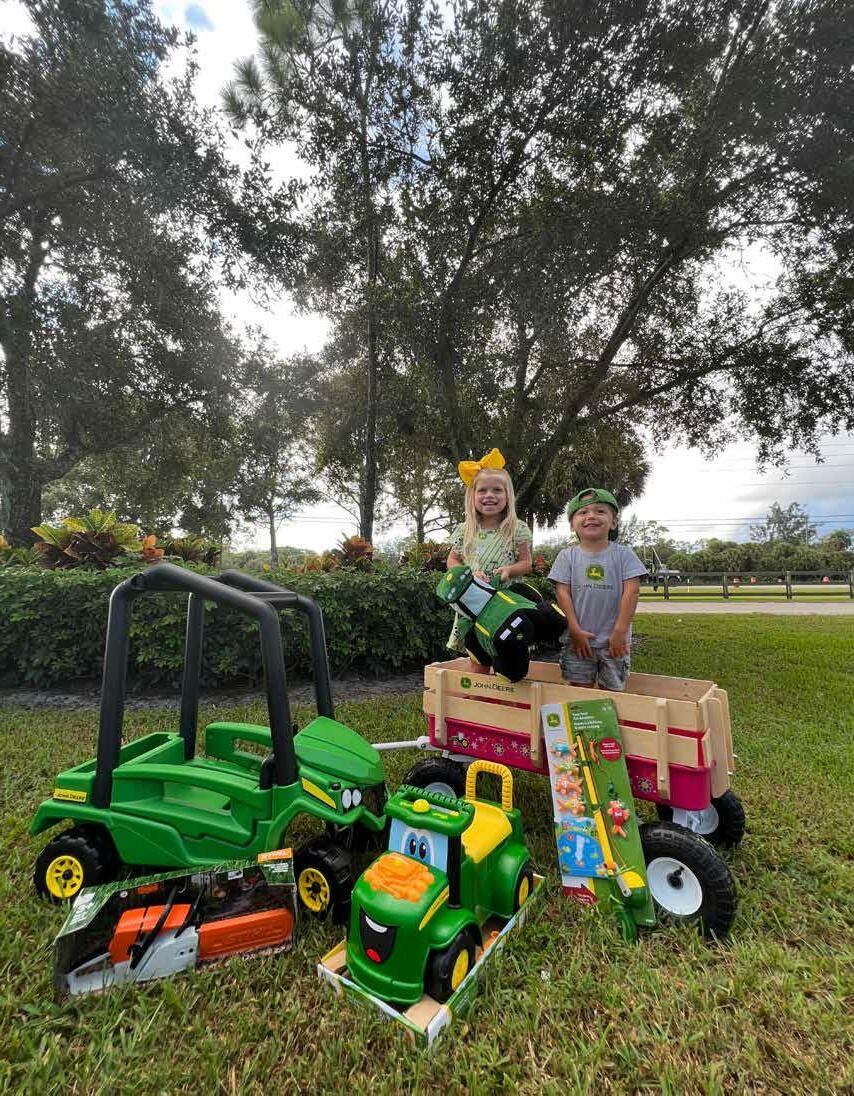
Letters, comments and questions can be sent to P.O. Box 5377, Plant City, Florida 33563-0042 or you are welcome to email them to: info@inthefieldmagazine.com or call 813-759-6909

Merry Christmas and Happy New Year!
Sarah Holt
The LORD make his face shine upon you and be gracious to you. - Numbers 6:25
Advertisers warrant & represent the descriptions of their products advertised are true in all respects. In The Field Magazine assumes no responsibility for claims made by advertisers. All views expressed in all articles are those of the authors and not necessarily those of Berry Publications, Inc. Any use or duplication of material used in In the Field magazine is prohibited without written consent from Berry Publications, Inc.
Published by Berry Publications, Inc.
WWW.INTHEFIELDMAGAZINE.COM INTHEFIELD MAGAZINE December 2022 6 PAGE



Big or small, we have toys for all this holiday season!
December. It sure seems like the year has gone by so fast. Hope you all had a good Thanksgiving. We had a good turnout for our annual dinner and meeting we held at the Starling’s Barn on Lake Buffum. There were some usual faces that we missed seeing but all in all a good turnout, considering we had to change the date at the last minute. The cake sale was successful for the cattlewomen, as I am sure that they appreciate everyone who chipped in to help support their scholarship fund. Florida Cattlemen’s President Wes Carlton came and gave us an update on the state association. He told us about all the fence supplies and feed, hay, etc. that had been donated to help out with our fellow cattlemen down south who suffered so much damage from the hurricane. If you are in the cattle business and are not a member, I would encourage you to join today. We are all in this together and if you look at the Florida that we knew, it is changing fast. We are a small minority of a large population that depends on farmers and ranchers to keep them fed, although seldom they understand our way of life and livelihood.

On another note, at least we are finally drying out a bit. The calf market is a little stronger, demand seems to

be there, just corn prices sure makes it hard to pencil out. Hopefully the New Year will be a prosperous one for all of you. Take care of your cows this winter and maybe they’ll take care of you next year. We are planning on a spring gathering and dinner for our members in April at the Stuart Center. Hope to see you all then.
In the meantime, here’s to wishing you all a Merry Christmas. And don’t forget the REAL reason for Christmas.
See you around,
WWW.INTHEFIELDMAGAZINE.COM INTHEFIELD MAGAZINE December 2022 8 PAGE
Polk County Cattlemen’s Association
Kevin Fussell

WWW.INTHEFIELDMAGAZINE.COM INTHEFIELD MAGAZINE December 2022 9 PAGE
FROM THE
SCIENTIFIC FIELD
By J. Scott Angle
for being “instrumental in breeding new varieties of strawberries such as pineberry, which we market as Pink-a-Boos.”
Whitaker has used Wish Farms acreage for years as part of his trials of new berries, as did Vance’s predecessor, Craig Chandler. Vance also credits Gary with being a marketer and proponent of his best-flavored varieties like Sensation® and Medallion®. Vance has provided technical advice on transplants and varieties to Gary’s side business, Harvest CROO Robotics.
Wish Farms has also hosted research by the UF/IFAS Gulf Coast Research and Education Center’s Natalia Peres involving the use of ultraviolet light system to control a pathogen called powdery mildew.
Gary has asked Steve Sargent of the UF/IFAS Horticultural Sciences Department to evaluate new clamshell packages and shipping containers for cooling efficiency. And Yiannis Ampatzidis of the UF/IFAS ABE is also advising Gary on the use of artificial intelligence in robotic harvesting.
I’ve got a lot of 100th birthday parties on my calendar these days. Only one featured ZZ Top.
Pixie Rock at Wish Farms in Plant City wasn’t, strictly speaking, a centennial celebration. The Wishnatzkis didn’t need to mark their milestone with a single blowout evening. They’re skillful stewards of their family and farm history on a daily basis.
Their #AgIsAmerica story starts on the streets of Manhattan in a single pushcart selling fruits and vegetables. It continues with the Wishnatzkis migrating to Hillsborough County. It unfolds today with the Wish Farms name and pixie mascot on millions of clamshells in homes across the nation.
In addition to its compelling rags-to-riches arc, Head Pixie (yes, that’s the title on his business card) Gary Wishnatzki presents the family history as a century of progress. Gary highlights the role of science in the farm’s history he so lovingly documents in Generations of Sweetness: Stories That Shaped My Family and the Journey to Wish Farms.
It starts with one of the most ancient of technologies—the wheel—and the embrace of innovation advances to today’s artificial intelligence-guided machine harvesting.
That’s where our stories—those of UF/IFAS and Wish Farms— intersect. We’ve been delivering science to Florida growers for even longer than there have been Wishnatzkis growing strawberries in Plant City. Hence my birthday party schedule.
Earlier this year I spoke at the 100th anniversary of our North Florida Research and Education Center in Marianna. Hurricane Ian postponed our turf science program centennial celebration that had been scheduled in Citra. In the next six months I plan to be at events marking a century of science at our Everglades Research and Education Center, our Department of Agricultural and Biological Engineering (ABE), and our Hastings Agricultural Extension Center.
But our history plays out on farms like Wishnatzki’s. So I am not surprised but gratified to see Gary include UF/IFAS in the Wish Farms story.
It’s there in the book on page 126. The photo of UF/IFAS strawberry breeder Vance Whitaker has a caption that credits him

Gary’s book wraps up with a nod to UF/IFAS for coming up with hundreds of varieties of strawberries over 75 years. The tie between science and agriculture will only get stronger. Innovation keeps Florida growers profitable against global competitors.
When I visited Gary in November, I could see from his dazzling year-old headquarters that he’s in this for the long haul. We talked in his treehouse lounge with curved walls and tilted windows that give it an Alice-in-Wonderland feel. I went down the wooden slide like a log on a flume. I marveled at the sculpture trees that give the space a cozy Hobbit feel. And the two of us grabbed strawberry-shaped guitars and had ourselves a ZZ Top moment.
The pushcart business had grown into a campus that could host a little ol’ band from Texas that had grown into arena rockers.
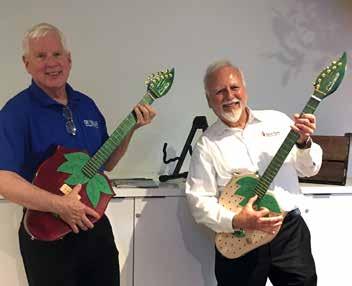
Gary’s son Nick, the Wish Farms manager of public relations (Pixie of the week when I visited, and busy shepherding a Good Morning America advance team around the property), will be the fourth generation of Wishnatzki to make a living in Plant City on strawberries.
There’s plenty more family involved in the business, including Gary’s wife Therese. The next generation are Vice President of Sales and Marketing James Peterson, who’s married to Gary’s daughter Elizabeth, and Nick, whose husband Stephen Cramer is in accounting. James and Elizabeth’s sons Will and Joey could be fifth generation Wish Farmers.
I believe they’ll run things in some ways like Gary has—with the help of science, with Vance and even with Vance’s successor.
Happy 100th, Wish Farms
WWW.I INTHEFIELD MAGAZINE December 2022 10 PAGE
Scott Angle is the University of Florida’s Vice President for Agriculture and Natural Resources and leader of the UF Institute of Food and Agricultural Sciences (UF/IFAS).
 By Marisol Tarango
By Marisol Tarango
THOUGHTS FROM THE HEIFER PEN

I shouldn’t be writing a Christmas column again already, but here I am and here is Christmas. If you have been reading this column for a while, you probably know that I love Christmas. I am not a festive person in general (people with festive personalities perplex me), but Christmas is an entirely different story. Christmas is supposed to be festive because it’s Christmas. There should be lights, and music, and sugar, and over tired children because they can sleep when Christmas is over. Christmas only comes once a year! I love almost every aspect of Christmas, the food, the family gatherings, the eggnog, the tamales, the music, the church plays, everything except one thing… writing the December column for this magazine.
Now don’t misunderstand me. I believe that every reoccurring form of media (T.V. shows, radio shows, blogs, magazines, music albums, ect) should have at least one Christmas themed episode each year. I mean, if a singer doesn’t have at least one Christmas album are they even that great of a singer? But the thing is, most of these are cliché, they tell the same story, which for most cases are ok. We all want the orphans to end up having a happy Christmas at the once selfish banker’s expense. We can all listen to the same songs sung by different singers, and we even look forward to putting the exact same decorations up year after year. But we will not stand to read the same contemplative essay or short story about a deeper understanding of Christmas or a new kindled love for sentimental traditions. I would venture to say that when we read these some of us at least think, “Didn’t I read this last year?”
Stories like…
The big shot Wall Street son comes home to the family farm for Christmas and discovers a better way of life. Favorite Christmas memories as a child that are often described while the author is doing the same traditions with their kids or grandkids. The Christmas miracle where the Christmas present is obtained, the family member who couldn’t make it somehow shows up last minute, or it snows when it was supposed to be a recordbreaking warm Christmas right after the climax of an almost ruined Christmas. Of course, there are stories that always warm the heart like the soldier making it home, the parents saving to buy their children that one special gift, and those stories should warm the heart. It’s the essays that rehash the “silent and holy night not the big box store night” that sometimes
make you want to throw the magazine across the room. It’s a writer’s worst nightmare to be compared to a Hallmark Christmas Movie. (Not to hate on Hallmark Christmas Movies, they are just not famous for creative story lines.)
Sometimes I have gone along with the act and kind of made a joke about Christmas clichés that are cliches because they are real, like getting a pony for Christmas or memorable gifts like a four-slice toaster (If you have a big family, you understand!). Other times I have just noted down my observations of how people enjoy Christmas in different ways or how different things about Christmas make us feel. But there is only so much I can do to avoid the mainstream Christmas remix of sentimental warm feelings. But maybe that is not completely necessary. My grandma has always had a soft spot for Christmas stories, and I think that is something that she has passed on to her grandchildren. I remember reading Christmas books with my grandma at night, all of the granddaughters would be gathered around her in our matching flannel nightgowns, how cold the tile floor would be on our feet until we could get settled on the couch. There was one story that she always read about how a dad went off to war, but before he left, he and his daughter picked out the Christmas tree for the church because it was their turn to do so. How when Christmas came her mom and her went to harvest the tree, and by the time they delivered it to the church it was dark, and the preacher thought that angels had delivered it because he heard them singing Christmas songs. And for the Christmas play the girl was the angel, and the mom made her angel costume out of her wedding dress and made a matching dress for a doll that she had got the daughter for Christmas and at the end of the night Santa Claus tells her that he has another present for her and it’s the dad. Even though that story was “cliché” (and I am not even sure it was true), we loved it and asked for it every year.
It’s hard to be original when it comes to the topic of Christmas because it is a very narrow topic. All of the cliché stories we hear every year point back to the first Christmas Story. A baby boy was born in a barn to grow up to save the undeserving human race from what we very much deserve. We celebrate Christmas every year to remind us of what was given to us and what we can look forward to in the future because of that Baby. And that is what I would call a creative story line.
WWW.INTHEFIELDMAGAZINE.COM INTHEFIELD MAGAZINE December 2022 12 PAGE

WWW.INTHEFIELDMAGAZINE.COM INTHEFIELD MAGAZINE December 2022 13 PAGE
Tampa Bay Fishing Report December 2022
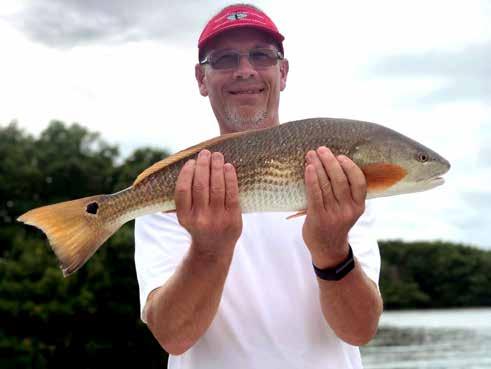
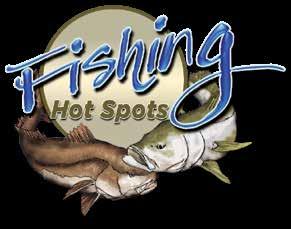


December means pleasant fishing days with lower humidity. It also means that winter is just around the corner, as are those wretched north and northeast winds, negative low tides, and cooler water.
Since winters are on the way, perhaps we should understand how cooler temperatures can affect fishing. Temperatures affect almost every living creature, including fish. Low temperatures have inconsistent sensitivity levels on most fish when it comes to hot or cold. Consequently, everything has a comfort zone when it comes to temperature. As a result, the key to a good day of catching is looking for water temperatures that support these zones. When you find them, you’ll typically find fish. Typically during the winter, you might find areas like rocks and deep bars, dark creeks, rivers, canal bottoms, and deeper protected waters around jetties holding feeding fish. So, what comfort zones are we looking for when trying to catch fish? Three of the most targeted fish by Tampa Bay inshore anglers are Snook, Redfish, and Trout. Their respective comfort ranges average overall around 70-86 degrees. Individually, Snook appreciate 56-84 water temperatures, Redfish 65-75, and Spotted Sea Trout feed readily when the water temperatures are approximately 65 degrees up to about 80 degrees. It doesn’t mean you can’t catch them with varying degrees of water temperature, but your
chances improve when water temps make them happy.

Snook Canals, rivers, creeks, and deeper muddy-bottom flats are winter Snook tickets. As the water cools, Snook look to these areas for protection, and you’ll frequently find them sunning on shallow bars near deeper water. Deep-water bridges, pilings, and docks along the Hillsborough, Alafia, Little Manatee, and Manatee Rivers are good starting places. Try baits like small finger-size mullets, cut ladyfish, pinfish, and jumbo shrimp. You’ll find them all over Tampa Bay from the southeast shore, including the Alafia River, Picnic Island, Simmons Park, Bishop Harbor, Cockroach Bay, Joe Island, all the way down into Bradenton and Sarasota. Fishing is also good around Weedon Island, 4th Street, Cypress Flats, Rocky Point, and the Double Branch area. Tampa Bay offers good Snook fishing, especially at night around lighted docks and bridges.
Redfish action during the winter months is usually hot. Schooling fish are common around the flats near Weedon Island, Double Branch, Rocky Creek, Simmons Park, Bishops Harbor, Tarpon Key, Indian Key, and Joe Island. It’s not uncommon for large Bulls to work the outer edges and channels on low-tide days. Redfish are notorious for working schools of large mullet. For that reason, if you’re serious about catching this awesome
WWW.INTHEFIELDMAGAZINE.COM INTHEFIELD MAGAZINE December 2022 14 PAGE
Capt. Woody Gore (www.captainwoodygore.com)
pugilist, learn to distinguish their wakes, typically more extensive and higher, from those of mullet. As you fish an area, be perceptive of any changes in water movement left, right, and ahead as this almost always indicates the presence of fish. Look for Redfish around many of the same areas as Snook.
Spotted Sea Trout Incoming or outgoing tides, live shrimp, artificial shrimp, Corks, and any good grass flat, and you’ll almost certainly catch Trout this month. Look for broken bottom areas (grass flats with plenty of potholes) around Pinellas Point, Tarpon Key, Fort Desoto, Picnic Island, Simmons Park, Bishop Harbor, and Joe Island down into Bradenton and Sarasota. Upper Tampa Bay sports good Trout fishing around Weedon Island, 4th Street, Cypress Flats, Rocky Point, and the Double Branch area. Fishing potholes for Trout can also produce the occasional tasty Flounder.
Cobia should begin showing up as the water temperatures drop in the panhandle. They show up first along the beaches during their migration and occasionally frequent our hot water runoffs around local power plants. Large shrimp, small crabs, and pinfish will do the trick. If you are interested in artificial lures, try a large worm bait about 8 to 10 inches rigged on a Jighead. Cobia cannot resist anything resembling an eel.
Other
Sheepshead around the bridges, oyster bars, rocky areas, and deep water docks should improve this month. Try using green mussels, shrimp, or oysters. Scrape the pilings to get them going.
Inshore Kingfish action should pick up along the beaches and Egmont Channel, particularly as the water temperatures drop.
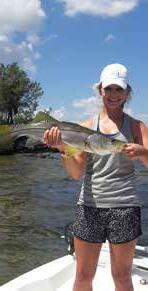
Grouper action is always good during the cooler months. Try trolling large jigs on down riggers or planners, or use a MirrOlure 25+ diving lure.
813-477-3814

Capt. Woody Gore operates Tampa Bay's #1 Outdoor Fishing Guide Services. Guiding and fishing in Tampa, St. Petersburg, and Clearwater areas for over fifty years, he offers first-class customer service, family-oriented charters, and a lifetime of memories.
Visit his website, www.captainwoodygore.com Email: fishing@captainwoodygore. com

WWW.INTHEFIELDMAGAZINE.COM INTHEFIELD MAGAZINE December 2022 15 PAGE
GIVE ME A CALL & LET'S GO FISHING
E r E d S p E ci ES Florida Bonamia
E ndang
By Libby Hopkins
The Florida Bonamia or the Bonamia grandiflora as it’s known by its scientific name, is a rare species of flowering plant in the morning glory family known by the common names Florida Lady’s Nightcap, Florida bonamia, and Scrub Morning Glory. It is endemic to Central Florida, where there are about 100 known populations remaining, many of which are within the bounds of the Ocala National Forest. The plant has declined in recent decades primarily due to the development of its habitat, which is being converted to urban zones and citrus groves. This is the primary reason that the plant was federally listed as a threatened species in 1987.
Florida Bonamia is a perennial flowering vine. Its showy blooms vary slightly in color from a bright blue in the morning to a pale lavender by the afternoon, at which time, the blooms close. They are solitary, five-lobed and funnel-shaped with white throats. Leaves are grayish-green and ovate with pointed tips, entire margins and tiny hairs.
They are alternately arranged. Stems are hairy and herbaceous, arising in multiples from a single woody root mass and extending outward in different directions along the ground, unlike other morning glory species, which tend to be high climbing. Fruits are capsules that usually contain four smooth, oblong seeds.
The plant occurs in Florida scrub habitat on deep, dry, white sand in clearings among sand pines (Pinus clausa) and other
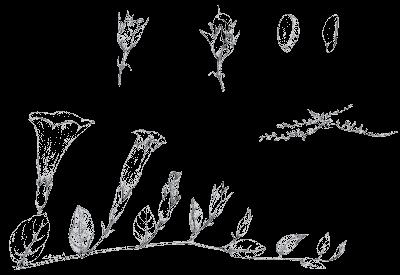

scrub flora. Other rare plants in the region include highlands scrub hypericum (Hypericum cumulicola), papery whitlowwort (Paronychia chartacea), scrub plum (Prunus geniculata) and scrub lupine (Lupinus aridorum).
It is adapted to the occasional wildfire that naturally occurs in the scrub habitat. Fire clears brush and heavy forest canopy which shade out the morning glory, providing the clearings that it requires.
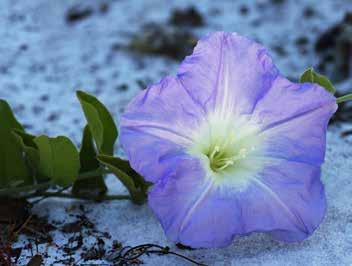
Fire suppression efforts are generally detrimental to the species. Controlled burns and other methods of clearing excessive vegetation are part of the recovery plan. Where the morning glory is provided appropriate habitat, it can become plentiful and even abundant. It has the capacity to introduce itself into newly cleared, sandy plots and take hold vigorously; however, it does not tolerate much disturbance once established.

WWW.INTHEFIELDMAGAZINE.COM INTHEFIELD MAGAZINE December 2022 16 PAGE


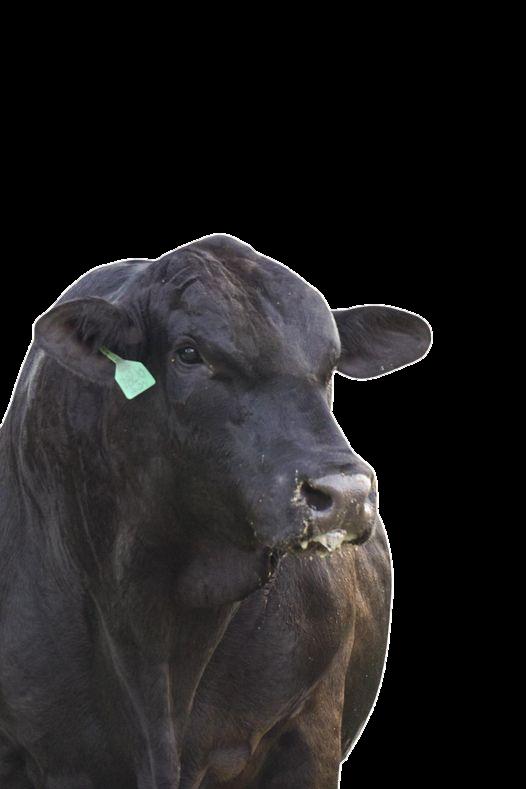










3 - 1 P M 3 - 1 P M L . 3 3 8 0 2 L . 3 3 8 0 2 S A L E S A L E F O R M O R E I N F O R M A T I O N P L E A S E C A L L : O F F I C E : 8 6 3 - 6 6 5 - 5 0 8 8 | D A V E : 8 6 3 - 5 5 9 - 3 2 6 6
From the best of the best in youth and open livestock competitions to education programs like Ag-Venture, there’s always something to learn, watch or do in agriculture at the Florida State Fair. Congratulations and thanks to all within our community who invest their time and effort and represent the rich agricultural heritage and future of Florida.

18 PAGE
JOIN US TO CELEBRATE ALL
AGRICULTURE THIS FEBRUARY! IntheField23 1 12/9/22 9:21 AM
THINGS
POLK COUNTY 4-H CLUB LIST HAINES CITY/DAVENPORT/POINCIANA
Bullseye 4-H: Archery (meets every 3rd Monday at 4:00pm in Haines City)
Country Ridge 4-H: Swine, Beef, Plants (meets every 2nd Monday at 6:30pm in Davenport)

AUBURNDALE/LAKE ALFRED/WINTER HAVEN Auburndale Community Church 4-H: Exploring 4-H (meets 2nd or 3rd Sunday at 3:30 pm in Auburndale)


Home Grown 4-H: Archery, Community Service, Sewing, Exploring 4-H (meets 2nd Tuesday at 1:00 p.m. in Auburndale)
Polk County Sea Stars 4-H: Marine Science (meets every 1st Friday 9:00 a.m. in Winter Haven)
Pure Country 4-H: Horse, Dog, Rabbit, Poultry, Horticulture, Crafts, Cooking (meets every 2nd Sunday at 3:00 p.m. in Lake Alfred)
Rowdy Ropers 4-H: Livestock, Natural Resources, Exploring 4-H (meets every 3rd Monday at 6:00 p.m. in Winter Haven)
Shooting Sports 4-H: Shotgun (ages 11 and up) (meets every 1st and 3rd Friday at 6:00pm in Winter Haven)

NORTH LAKELAND/KATHLEEN/POLK CITY
All Stars 4-H: Archery, Community Service, Dog, Public Speaking, Dog Enthusiasts (meets 1st,2nd,3rd Thursday, at 1:00pm; and every Friday at 3:30 pm in Lakeland)
American Pride 4-H: Chickens, Family & Consumer Science, Community Service, Horse (meets every 2nd Thursday at 6:30 pm in Lakeland)
Barnyard Buddies 4-H: Rabbit, Citizenship, Craft, Plants (meets every 1st and 3rd Monday at 6:30 pm in Polk City)
Green Swamp 4-H: Archery, Hunting & Wildlife (meets every 1st Saturday 11:00am in Polk City)
Hog Wild 4-H: Hog, Chicken, Rabbits, Plants, Crafts, Judging (meets last Monday at 6:30pm in Plant City)
Hoof-n-Horn 4-H: Photography, Beef, Swine (meets every 2nd Sunday at 2:00pm in Lakeland)

Kathleen Cattle Crew 4-H: Cattle, Swine (meets 3rd Monday at 6:30 pm in Lakeland)


Show N Out 4-H: Welding, Archery, Canning, Woodworking (meets every 2nd Monday at 6:00 pm in Lakeland)
Southern Souls 4-H: Cattle, Swine, Poultry, Rabbits, Archery (meets every 2nd Thursday at 6:00 pm in Lakeland)

the 4-H office at
shreemoyee,gosh@ufl.edu
FMS Super-Mol Blocks, Tubs, and Super-Pro Blocks providing the protein, energy and vital nutrition that your cattle need to stay in tip top shape during the fall and winter changes to your forages Proper nutrition matters for pregnancy rates, healthy calves, and high performing cattle throughout the

Thank you for trusting us to make and distribute the very best products and minerals for your livestock We wouldn't be here without amazing customers like you! Wishing you a blessed holiday.
~ The Clarks

WWW.I INTHEFIELD MAGAZINE December
Supplement your cattle with the tastier trace mineral option! Our Tubs Mi fortified with no
G I V E U S A C A L L A N D L G R E G 8 1 3 - 7 C H E C K U S O U T O R F O L L O W U S
For more information Call
863-519-1043 or email











































WWW.INTHEFIELDMAGAZINE.COM INTHEFIELD MAGAZINE December 2022 20 PAGE The Oak Ridge Boys Front Porch Singin’ Tour Thu. Mar. 2, 3:30 $30 Sara Evans Sat. Mar. 4, 3:30 $35 Neal McCoy Mon. Mar. 6, 3:30 $30 Chris Young Sun. Mar. 5, 7:30 $60 Keith Sweat Sat. Mar. 11, 7:30 $40 Walker Hayes Thu. Mar. 2, 7:30 $40 Wayne Newton Fri. Mar. 10, 3:30 $40 The Jacksons Wed. Mar. 8, 7:30 $40 Tanya Tucker Wed. Mar. 8, 3:30 $35 SAWYER BROWN Sat. Mar. 11, 3:30 $30 Willie Nelson & Family Fri. Mar. 3, 3:30 $50 CHRIS “LUDACRIS” BRIDGES Sat. Mar. 4, 7:30 $40 CeCe Winans Tue. Mar. 7, 7:30 $25 Josh Turner Mon. Mar. 6, 7:30 $35 Root & Boots Aaron Tippin, Collin Raye and Sammy Kershaw Tue. Mar. 7, 3:30 $35 Train Fri. Mar. 10, 7:30 $50 HALESTORM Fri. Mar. 3, 7:30 $45 The Gatlin Brothers Sun. Mar. 5, 3:30 $25 Lynyrd Skynyrd Sun. Mar. 12, 7:30 $60 FOR KING + COUNTRY Thu. Mar. 9, 7:30 $40 TOMMY JAMES & THE SHONDELLS Thu. Mar. 9, 3:30 $35 Concert dates and times are subject to change Home of OUR Tickets On Sale Now! • FLstrawberryfestival.com Visit FLstrawberryfestival.com or call 813-754-1996 and get your tickets for the best seats available! #berryfest23 • T-Mobile • Alessi Bakeries • AMSCOT • Astin Farms • Candyland Warehouse • Global Frequency Technology • TRUFFOIRE • Circle K • Local Ford Dealers • O’Reilly Auto Parts • Grove Equipment Service • Stingray Chevrolet • Uncommon USA • ZYN • Monticciolo Sedation Dentistry • Netterfield’s Concessions • Verizon Wireless • Badcock Home Furniture &More • Good Health Saunas • Dakin Dairy Farms • Krazy Kup • Lazydays RV • DIRECTV • Images Everywhere! • Master Spas • Florida Blue • Local Ford Dealers • Wyndham Destinations • Entenmann’s • Portillo’s Hot Dogs • The Bank of Tampa The Leroy Van Dyke Country Gold Tour Featuring Leroy Van Dyke, T.G. Sheppard, Mandy Barnett and T. Graham Brown Sun. Mar. 12, 3:30 $35 Mar. 2 -12, 2023 Plant City, FL We Have a Winner! Artists Appearing on the Soundstage: CANCELED
“Jingle Bells”

not Christmas. The




In the Netherlands, Sinterklaas (the Dutch version of Santa Claus) arrives from Spain, not from the North Pole.

Hallmark introduced their first Christmas cards in 1915.
Ever wonder about the string on a box of animal crackers? Introduced around Christmas in 1902, the string was intended to be used to hang the cracker boxes on your Christmas tree.

WWW.INTHEFIELDMAGAZINE.COM INTHEFIELD MAGAZINE December 2022 21 PAGE
Washington Irving is credited with creating Santa’s flying sleigh in 1819 and cartoonist Thomas Nast began illustrating our current image of Santa in Harper’s Weekly in 1863.
was written for Thanksgiving,
song was written in 1857 by James Lord Pierpont and published under the title “One Horse Open Sleigh.” It was supposed to be played in the composer’s Sunday school class during Thanksgiving as a way to commemorate the famed Medford sleigh races.
Figures of Speech
At a recent Plant City Chamber of Commerce Contact Breakfast I sat at a table with three local funeral home managers, Edwena Haney, Verna McKelvin and David Wolf. Edwena used a phrase I had not heard for years. She ended a sentence with “As a figure of speech.” “Figure of Speech,” now just what does that mean?
I went to Google on my computer and looked it up, and this is what I found:

Figures of speech
An expression that uses language in a nonliteral way, such as a metaphor or synecdoche, or in a structured or unusual way, such as anaphora or chiasmus, or that employs sounds, such as alliteration or assonance, to achieve a rhetorical effect.
Huh? No kidding. I do declare. I asked around to see if I could get an answer. Nobody seemed to know. I’ll bet if my English teacher, Mrs. Smith, Mac Smith’s mother, was alive she would have an answer I could understand.
As a last resort I went back to Google for the answer. I did not get an answer I could understand, but I found some examples of “Figure of Speech.”
You do not need a parachute to skydive. You only need a parachute to skydive twice. The evening news is where they begin with “Good Evening,” and then proceed to tell you why it isn’t. Light travels faster than sound. This is why some people appear bright until you hear them speak. Knowledge is knowing a tomato is a fruit. Wisdom is not putting it in a fruit salad. If I agreed with you, we’d both be wrong. The last thing I want to do is hurt you. But it’s still on my list. Change is inevitable, except from a vending machine. Where there’s a will, there are relatives. And lastly the one most everyone can understand. Well, his goose is cooked! There you have it. Now you know a figure of speech when you hear it or read it.
As a kid I remember we would have fun seeing who could come up with the most tongue twisters. The most familiar most people remember is: Peter Piper picked a peck of pickled peppers. A peck of pickled peppers Peter Piper picked. If Peter Piper picked a peck of pickled peppers how many pickled peppers did Peter Piper pick?

See if you can read this one without making a mistake. How much wood would a woodchuck chuck if a woodchuck would chuck wood? A woodchuck would chuck all the wood he could chuck if a woodchuck would chuck wood.

Try these two: But the thought I thought wasn’t the thought I thought I thought. If the thought I thought I thought had been the thought I thought, I wouldn’t have thought so much.
A skunk sat on a stump. The stump thought the skunk stunk. The skunk thought the stump stunk. What stunk the skunk or the stump?
I have always thought the dictionary is filled with words that are seldom used. Open any page and you’re likely to find a word you have never heard, whether it’s gongoozle, which means to stare idly at a watercourse and do nothing, or zwodder, a feeling of drowsiness. We see it, and think to ourselves that we absolutely must use it in conversation.
Sometimes people never understand what you’re saying. They hear what they want to hear. Point in case! About a week before this last Christmas I was at the checkout stand at a local grocery store. The lady in front of me wanted to buy some postage stamps to mail some Christmas cards. Here’s the way the conversation went.
“Ma’am, I got these Christmas cards I need to mail today. I need 14 stamps, please.”
The clerk said, “O.K., I have books of 6 first class or 12 second-class stamps.” “OK”, she said. “I’ll take 14 second-class stamps.”
“I’m sorry,” the clerk said, “We only sell the stamps in books of 12.” “Yes. I need 14 stamps, please.”
The clerk replied, “Okay. So two books will be $11.04.”
The customer replies, “What! That seems like a lot of money for 14 stamps.” Clerk: “No, madam. That is for 24 stamps. We only sell them in books of 12.” Customer: “But I only want 14.”
The clerk remained calm and said. “Lady, we are not a post-office, we only sell stamps in books of 12. In order to get 14 stamps you will have to buy two books. I am sure you can use the rest of the stamps later. Now, if it’s a real problem there’s a post office just around the corner past the fire station, which will be open in the morning.”
Very loudly she says, “Don’t you understand I only need 14 stamps?”
The clerk at the cash register politely said, “Sorry, I cannot help you.” With that the lady said, “ Well give me one book!”

She turned and looked at me and said, “I’ll hand deliver the other two cards tomorrow.”
People not only hear what they want to hear, but have trouble writing what they want to say. As an example, here are some notes a teacher friend of mine collected over the years.
“My son is under a doctor’s care and should not take P.E. today. Please execute him.”
“Please excuse Lisa for being absent. She was sick, and I had her shot.”
“Please excuse Jennifer for missing school yesterday. We forgot to get the Sunday paper off the porch, and when we found it Monday, we thought it was Sunday.”
“Please excuse Jason for being absent yesterday. He had a cold and could not breed well.”
And I leave you with this, which has nothing to do with anything written in this column.
“If you can’t have a midnight snack why do we have a light in the fridge?
WWW.INTHEFIELDMAGAZINE.COM INTHEFIELD MAGAZINE December 2022 22 PAGE
Editor’s Note: This Rocking Chair Chatter was originally printed in the December 2015 issue


For more information, contact the Florida Department of Agriculture and Consumer Services IndustryMKT@FDACS.gov | 850-617-7399 | FDACS.gov Go with The Logo They Know 9 out of 10 consumers are more likely to purchase products labeled “Fresh From Florida” Join the “Fresh From Florida” Program Membership Fee is $50/year

WWW.INTHEFIELDMAGAZINE.COM INTHEFIELD MAGAZINE December 2022 24 PAGE

WWW.INTHEFIELDMAGAZINE.COM INTHEFIELD MAGAZINE December 2022 25 PAGE























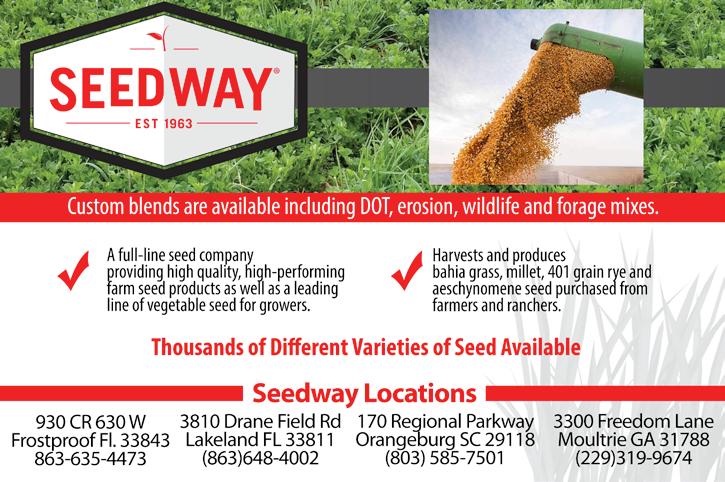
WWW.INTHEFIELDMAGAZINE.COM INTHEFIELD MAGAZINE December 2022 26 PAGE Is your farm FSMA ready? www.FDACS.gov/FSMA Sign up today for a free On-Farm Readiness Review This publication is supported by the Food and Drug Administration (FDA) of the U.S. Department of Health and Human Services (HHS) as part of a financial assistance award U2FFD007446 totaling $1,166,732 with 100 percent funded by FDA/HHS. The contents are those of the author(s) and do not necessarily represent the official views of, nor an endorsement, by FDA/HHS, or the U.S. Government.
FLORIDA SHALLOTS
By Sandy Sun, M.S. Clinical Medicines, B.S. Nutrition Science
The shallot, a lesser known cousin of garlic, is also a culinary and nutrition superstar. A member of the allium family, along with onions, chives, and garlic, the shallot is high in vitamins, minerals, and a host of nutrition-boosting compounds, such as flavonoids and polyphenols. Some of these compounds may help combat heart disease, strokes, and cancer, as well as lower blood pressure and cholesterol. During the cooler fall and winter months is the perfect time to plant shallots and onions.
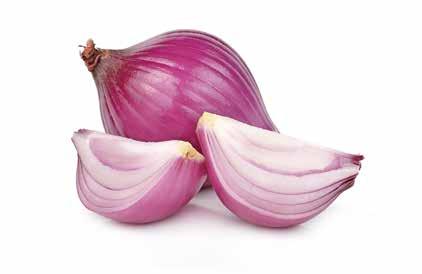
Shallots are very much like scallions (green onions) but grow in clusters of small bulbs similar to garlic. They look like smaller onions with a papery skin. Once peeled, the color is like that of a small red onion, and you can separate them into cloves as you would garlic. You can slice or dice them to eat raw or cooked. Both the leaves and the bulbs are edible and delicious with a delicate, mild flavor of both spicy and sweet notes. When cooked, the flavor is sweet and caramelized. The most common varieties are Jersey shallots and French Grey shallots.
NUTRITIONAL PROFILE
Fresh shallots are low in calories with little to no fat, sodium or cholesterol. Shallots contain a large number of active compounds that may help ward of cancer, heart disease, high blood glucose, and strokes. They may also help lower blood pressure and cholesterol and support the immune system. Like onions, garlic, and other alliums, shallots have antibacterial and antifungal properties.
Shallots are an excellent source of vitamins and minerals. According to the United States Department of Agriculture (USDA) National Nutrient Database for Standard Reference, a 100g serving of fresh shallots contains 72 calories, 2.5 g protein, 0.1 g fat, 17 g carbohydrate, and 2.5 g of dietary fiber. It also provides 15% of the Daily Recommended Value (%DV) for vitamin B6, 13% for vitamin C, 5% for magnesium, 4% for phosphorus, and significant amounts of folate and potassium.
Promote a Healthy Heart
Shallots are very flavorful, thanks to its sulfur-containing compounds. These include allicin and sulfoxides, which also give alliums many of its health-boosting properties. Hydrogen sulfide gas also keep blood vessels dilated and relaxed and in turn, it keeps blood pressure lower.
Shallots promote cardiovascular health in other ways as well. This allium can lower blood triglycerides and total cholesterol. It also lowers inflammation from oxidative stress by neutralizing highly reactive oxygen molecules and preventing them from damaging blood vessel linings. This helps decrease the risk of heart attack and atherosclerosis. Additionally, shallots can reduce the risk of clots in blood vessels by preventing clumping of platelet cells.
Fight off Disease
Shallots have many compounds that help fight off disease. It has both antibacterial and antiviral properties and may also help fight off infection from other microbes including yeasts/ fungi and worms. Shallots are also a good source of selenium, a trace mineral that must be obtained from the diet. Selenium plays an important role in making antioxidant enzymes and preventing certain cancers and heart disease.
How to Select and Store
Fresh shallots are the best choice for maximum flavor and nutrition. Choose fresh cloves that are plump and firm with intact skin. Avoid any that are soft, shriveled, or sprouting. Store fresh shallots uncovered in a cool, dark place away from heat and sunlight. Whole heads can be stored for up to a month in room temperature. When ready to use, take the head of shallot and separate into the individual cloves by applying firm pressure with your hand or a knife. Remove the skin from the individual cloves by smashing or tapping with a knife until the skin loosens.
How to Enjoy
Shallots are delicious eaten raw or cooked. Raw minced shallots can be added to salad dressings, butter, and sauces. When cooked, shallots develop a sweet, mellow flavor. Shallots can be fried, pickled, roasted, or sauteed. More ways to enjoy fresh shallots include:
• Cut off the top ¼ inch of a whole head of shallot, drizzle with olive oil, and roast in the oven for a creamy, mellow flavor
• Infuse your favorite oil with shallot cloves to drizzle over any dish
• Sauté minced shallots to add flavor to any pasta sauce, meat, or vegetable dish
• Mince and mix with herbs to create a crust for roasted meats
• Mince and add to marinades, salad dressings, dips, or cream cheese
• Slice or dice and use in any stir-fry
• Fry sliced shallots and use as a crispy topping for casseroles or soups
• Dice and sauté with garlic and onions to build up flavor in any dish
Enjoy the delicious aroma and flavor of fresh Florida shallots today while boosting your heart health.
SELECTED REFERENCES
http://edis.ifas.ufl.edu/ http://sarasota.ifas.ufl.edu/
WWW.INTHEFIELDMAGAZINE.COM INTHEFIELD MAGAZINE December 2022 27 PAGE
4-H: AN OPPORTUNITY FOR ALL
By Jim Frankowiak and
Shreemoyee Ghosh – 4-H Youth Development Agent Photos by: Shreemoyee Ghosh
When you hear 4-H, what is the first thing that comes to your mind? If it’s animals, you are correct BUT there is so much more to 4-H. 4-H provides opportunities for all youth through its three major priority areas- STEM and Agriculture, Citizenship and Leadership and Healthy Living. 4-H is America’s largest youth development organization, empowering nearly 6.5 million young people with the skills to lead for a lifetime. The organization is delivered by Cooperative Extension, a community of more than 100 public universities across the nation that provide experiences where young people learn by doing. For more than 120 years, 4-H has welcomed young people of all beliefs and backgrounds, giving kids a voice to express who they are and how to be productive citizens for their club, community, country, and the world.
4-H programs began providing Florida’s young people with educational activities as early as 1909, in cooperation with the state’s land-grant universities. In Florida we have two land grant universities – FAMU and UF. While FAMU provides opportunities near Tallahassee area, UF has an extension office in all 67 counties with a 4-H program in place to serve youth. Volunteers are the backbone of a 4-H program and the mission to utilize a learn-by-doing approach to help young people gain the knowledge necessary to become responsible, productive citizens is accomplished by i) Creating safe and inclusive learning environments ii) Involving caring adults and iii) Utilizing the expertise and resources of the University of Florida, as well as the nationwide land grant university system.
In 2021-2022, Polk County 4-H served 1582 youth through community 4-H club, school-based projects and special in-
terest clubs. These programs were supported by 191 adult and youth volunteers. Programs and activities of the local 4-H program are supported by the Polk County 4-H Foundation, in-kind support of volunteers, Polk County Government and Florida 4-H Headquarters. The 4-H program year is from September 1- August 31 and is open to all youth ages 5-18 years as of September 1 of the current year. 4-H has many delivery platforms such as Community Clubs, School-Based Programs, Special Interest Club and Camps.
Polk County prides in having more than 30 community clubs throughout the county and offers projects like Archery, Woodworking, Outdoor Skills, Photography, Scrapbooking, Gardening, Natural Resources, Culture and Cuisine, Animal Science, Horse Project etc. through these screened volunteer led Community clubs. These clubs meet throughout the year with each club providing opportunities for service learning, demonstrations to showcase project mastery, recognition, fundraising opportunities in addition to offering learning experiences through self-chosen projects. Research shows that 4-H delivered through community clubs has the most impact on youth as they provide multiple layers of positive youth development experiences. They are youth led, volunteer driven, and agent supported while providing the longest participation duration which enables the development of the four essential elements-belonging, mastery, independence, and generosity.
Through school-based programs, Polk County 4-H currently offers Public Speaking, Gardening and Bee Projects for elementary aged youth. In 2021-2022, 920 youth completed the Public Speaking Project and nine schools competed at the
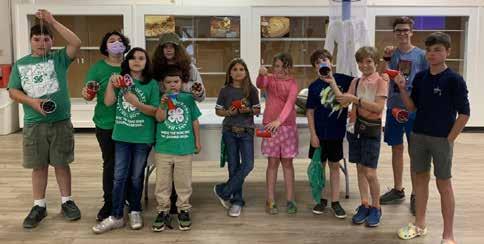

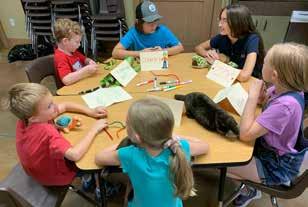
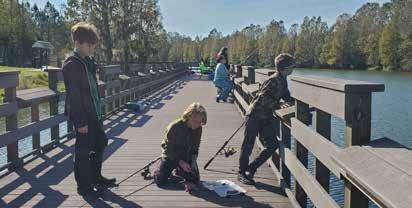
WWW.INTHEFIELDMAGAZINE.COM INTHEFIELD MAGAZINE December 2022 28 PAGE
final County contest for first, second and third place school winner and a $300 camp scholarship to the winning youth. Special Interest Clubs (SPIN) are short term project specific clubs and are seasonal in nature. Youth are encouraged to be a part of a community club to join a SPIN Club as community clubs provide multiple layers of positive youth development experiences. Some of the 4-H SPIN clubs we offer are
• 4-H Small Engines Club- A collaboration between Florida Flywheelers, Polk and Hardee County 4-H
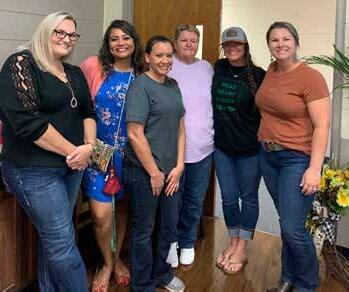
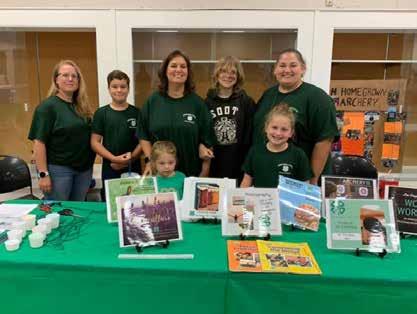
• 4-H Fishing Skills Club


• 4-H Bee Project (through school-based program) Camps are a popular way of experiencing 4-H for 4-H youth as well as non 4-H youth. Day camps are offered during Spring and Summer. Florida 4-H also offers overnight residential camping at Camp Cloverleaf for all youth ages 5-18 years. Some of the popular day camps are:
• Virtual International Culture Exchange between youth from Florida, Kentucky, and Iraq
• Astronomy
• Florida Wildlife
• Culture Through Cuisine
• Tailgating: The art and science of outdoor cooking
• STEM focused camps
• Art
As a bonafide 4-H member youth have the opportunity to participate in both Competitive and Non-Competitive events and balance cooperative learning activities in an informal education program at a county, district, state and national level. All events and activities are specifically designed to provide hands-on education to the three primary 4-H programs: STEM & Agriculture, Citizenship & Leadership and Healthy Living. These events give members positive, meaningful experiences by providing physical, mental, social and emotional growth opportunities.
The 4-H motto is “To make the Best Better,” and the organization’s slogan is “Learning by Doing.” “Our vision aims to make Florida 4-H the leading youth development program that creates positive change in youth, families and communities,” said Shreemoyee Ghosh, 4-H Youth Development Agent, UF/Polk County.
The 4-H pledge is: “I pledge my head to clearer thinking, my heart to greater loyalty, my hands to larger service and my health to better living. For my club, my community, my country and my world.” Ghosh noted “the motto, slogan, vision and
pledge all coincide with our goal to help youth develop into productive citizens.”
4-H enrollment is open throughout the year so hurry and gift your youth this opportunity of a lifetime by being a part of this premier youth organization- 4-H. For information to join please contact the 4-H office at 863-519-1043 and follow us on Facebook (Polk County 4-H ) and Instagram (@4hpolk) to stay abreast with Polk County 4-H Opportunities.
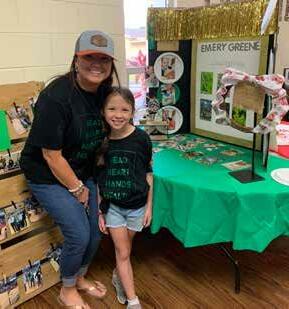
WWW.INTHEFIELDMAGAZINE.COM INTHEFIELD MAGAZINE December 2022 29 PAGE
Wish Farms Celebrates its 100th Anniversary with PixieRock®
Plant City based, international grower and year-round marketer of strawberries, blueberries, blackberries, raspberries and pineberries, Wish Farms, celebrated a major milestone. The company welcomed guests to its 100th anniversary celebration, the second annual, PixieRock® music festival.



The event took place Saturday, November 12, on the front lawn of the Wish Farms’ headquarters in Plant City. Attendees rocked to live performances from world-renowned artists Blanco Brown, Saint Motel, Bishop Briggs and headlining act, ZZ Top. PixieRock® featured gourmet food, hand-crafted beverages, and a silent auction featuring one-of-a-kind items and experiences.
“PixieRock® was born out of our family’s love for live music and a desire to support great causes,” said Gary Wishnatzki, Wish Farms third generation owner and self-proclaimed, Head Pixie. “Not only does this give us an opportunity to make a difference in our community, it gives our employees, growers, vendors, customers and friends a chance to celebrate all who have contributed to our century of success.”
The event raised money for the company’s charitable giving throughout the year and beyond. Begun in 2019, The Wish Farms Family Foundation has been focused on three pillars: food insecurity, youth education, and community. With the company covering the costs of the event, all proceeds from ticket sales and sponsorships went to beneficiaries Feeding Tampa Bay, Shriners Children’s and the Wish Farms Family Foundation. Funds raised at the silent auction benefitted Redlands Christian Migrant Association.
The event had 56 corporate and individual sponsors. Top industry donors were Jerue Trucking, Sonoco Highland, Farm Credit of Central Florida, Patterson Companies, Packaging Corporation of America, and Sweet Life Farms.
“This year’s PixieRock® raised an astounding $640,000. We had an amazing energy and response from the community. Seeing the legendary ZZ Top perform here was the icing on our birthday cake,” said Wishnatzki. “This impressive amount raised would not be possible without the generosity of our fifty-six sponsors and more than 1,100 attendees.”
About Wish Farms:
FEEL GOOD. EAT BERRIES. MAKE A DIFFERENCE.
It isn’t just a catchy phrase, giving back is engrained in the company culture. Through the Wish Farms Family Foundation, a portion of profits are dedicated to their three pillars of giving: Food Insecurity, Youth Education and Community. With a defined mission, they hope to make the world a better place.
Founded in 1922, Wish Farms is a fourth-generation, family operated company. As a year-round supplier of strawberries, blueberries, blackberries, raspberries, and now Pink-A-Boo Pineberries®, it grows both conventional and organic varieties. Nationally recognized for innovation, Wish Farms utilizes patented traceability technology to ensure quality and safety by tying consumer feedback to specific information from each day’s harvest. For more information, please visit www.wishfarms.com.
Founded in 1922, Wish Farms is a fourth-generation, family operated company. As a year-round supplier of strawberries, blueberries, blackberries, raspberries, and now Pink-A-Boo Pineberries®, it grows both conventional and organic varieties.
WWW.INTHEFIELDMAGAZINE.COM INTHEFIELD MAGAZINE December 2022 30 PAGE




WWW.INTHEFIELDMAGAZINE.COM INTHEFIELD MAGAZINE December 2022 31 PAGE Tune in to hear the lastest about our local Ag community @InTheFieldMagazine NEW EPISODE OUT NOW! www.inthefieldmagazine.com
Christmas on the Ranch
By Maggie Fussell
This month we celebrate Christmas with the carols, the movies, the baking, and the traditions. Christmas is a hectic but a wonderful time. It is a time of giving and a time of honor. We give gifts to those we love, and we honor Jesus Christ as the savior of the world.
As farmers and ranchers, Christmas time is not only about shopping. This month means working on the crops and working on the cattle. Agriculture is an ever-changing business. Unexpected things happen, the work is long and there are no days off.


For my cattle ranching family, December is a busy month. But, throughout the work we find time to spend with family and complete our seasonal traditions. Christmas movie nights, cookie decorating, making reindeer food and reading the Christmas story from the Bible.
This is one of my favorite times of the year because of traditions and the ranch. Christmas on the ranch is always different. I love to see the new calves with their floppy ears. Watch the ryegrass turn the pastures green. See the yearlings grow in their bushy winter coats. Finally, to see the sunrise each morning in the fog and watch the sunset each evening behind the cypress and oak trees.
Christmas on the ranch is a busy day full of thanksgiving, family, and food. There is a little bit of work involved because the animals are hungry, too. The yearlings have to eat before my family and I
go to Pa and Mam-maw’s house for dinner. If you don’t feed the yearlings early enough, they gather around the gate and protest with their lowing. Next, we have to feed the horses, the chickens, the cats and the dogs. Then, we have to drive through the pasture and check on the heifers that are having their first calves. After the animals are cared for we can take a small break and enjoy the day.
When Christmas is over it is back to a full day of work. Making sure the yearlings are fed, the cows have hay, checking on the calves, and fixing fences that are down. I am thankful for every Christmas on the ranch, for the animals with their unique personalities, and for my family and the work they do every day. I am most thankful for God’s blessings upon my family and the ranch this year.
Whether you’re on a farm, a ranch, or in the city I wish you a Merry Christmas! May this season be full of fun traditions, good memories, and a little chilly weather.
WWW.INTHEFIELDMAGAZINE.COM INTHEFIELD MAGAZINE December 2022 32 PAGE
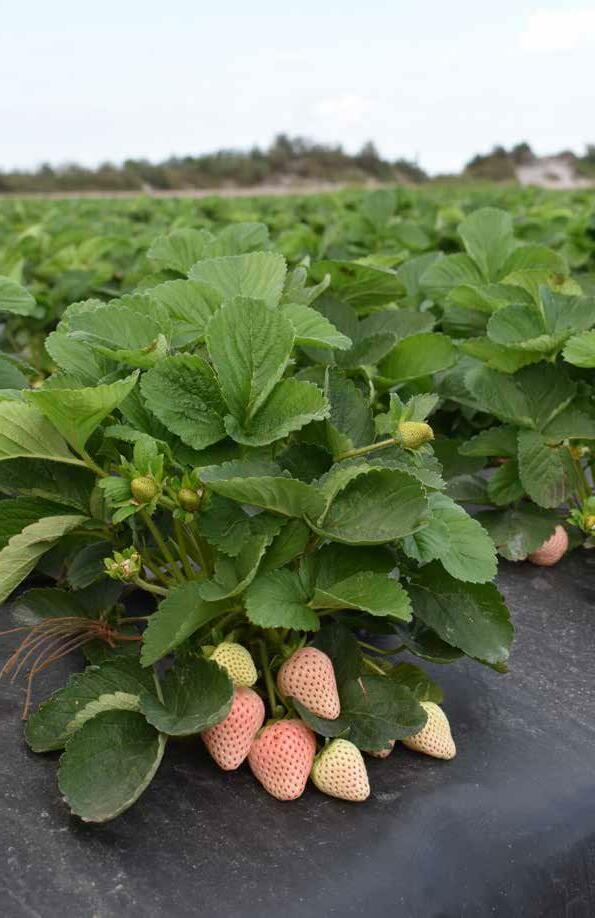
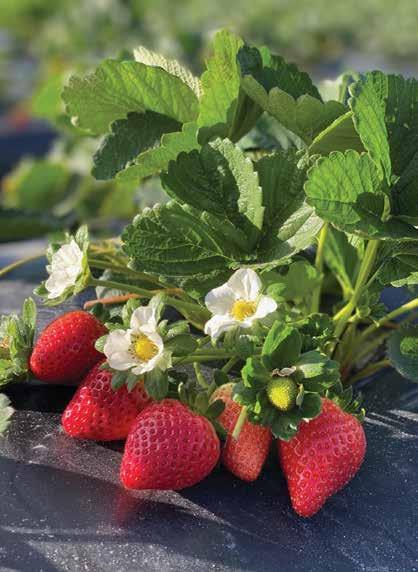

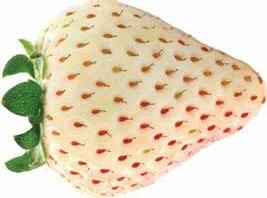
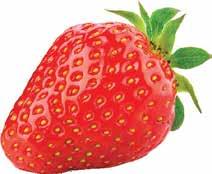



WWW.INTHEFIELDMAGAZINE.COM now In SEasoN! Strawberries & Pineberries FLORIDA


WWW.INTHEFIELDMAGAZINE.COM INTHEFIELD MAGAZINE December 2022 34 PAGE
NEWS BRIEFS
 Compiled by Jim Frankowiak
Compiled by Jim Frankowiak
USDA Grant to Connect Florida Schools with Underserved Farmers/Producers
The Florida Department of Agriculture and Consumer Services (FDACS) has signed an $11.4 million cooperative agreement with the U.S. Department of Agriculture (USDA) under the Local Food for Schools Cooperative Agreement Program (LFS). The program provides grant funds to the FDACS Division of Food, Nutrition, and Wellness (FNW) to connect underserved farms with Florida schools participating in the National School Lunch Program (NSLP) or School Breakfast Program (SBP).
USDA Launches New Online Loan Assistance Tool
Farmers and ranchers now have a new, U.S. Department of Agriculture (USDA) online tool to help them navigate the farm loan application process. It can be accessed at https://lat. fpac.usda.gov and helps determine eligibility for a Farm Service Agency farm loan, loan options and available help for completing forms.
FDACS Temporarily Suspends BMP Visitation Visits
The Florida Department of Agriculture and Consumer Services (FDACS) has temporarily suspended Best Management Practice (BMP) implementation verification visits for several counties, including Hillsborough and Polk, impacted by Hurricane Ian. The emergency order covers the November and December timeframe and may be extended, if deemed necessary.
USDA Surveying Producers to Increase/Improve Access
The U.S. Department of Agriculture (USDA) is surveying producers nationwide to help improve and increase access to its programs and services for farmers, ranchers and land managers. The survey is gathering information on programs available through USDA’s Farm Service Agency (FSA), Natural Resources Conservation Service (NRCS) and Risk Management Agency (RMS). The survey is available online at: farmers.gov/survey.
full. Avoid letting the water run continuously in the rinsing sink.
• Select the proper size pans for cooking. Large pans require more cooking water than may be necessary.
• Scrape food scraps into the garbage can or a composting bin, rather than rinsing them into the sink’s garbage disposal. A garbage disposal uses up to 4.5 gallons of water per minute.
• Run your dishwasher only when you have a full load. Dishwashers use between 7 and 12 gallons per load. For more water conservation tips, please visit the District’s website at WaterMatters.org/Conservation.
USDA-NRCS Offers Conservation Funding Opportunities
The USDA Natural Resources Conservation Service (NRCS) in Florida has several assistance opportunities for agricultural producers and private landowners for key programs. This includes the Environmental Quality Incentives Program (EQIP), Conservation Stewardship Program (CSP), Agricultural Conservation Easement Program (ACEP) and the Regional Conservation Partnership Program (RCPP).
Through these conservation programs, NRCS provides technical and financial assistance to help producers and landowners make conservation improvements on their land that benefit natural resources, build resiliency and contribute to the nation’s broader effort to combat the impacts of climate change. To learn more, contact the NRCS office at 201 South Collins Street, Suite 201, Plant City, FL 33563. Telephone: 813/7521474.
NRCS Seeks New Website Feedback
The U.S. Department of Agriculture (USDA) Natural Resources Conservation Service (NRCS) is seeking feedback on its new website. The new website, NRCS.USDA.GOV, is designed for farmers, ranchers and forest landowners who use or want to learn more about NRCS programs. Although the new site is a work in progress with added content coming soon, the NRCS wants public comment to help improve the site.

District offers Ways to Save
Water
and Money During the Holidays
The Southwest Florida Water Management District (District) is offering six easy ways to prepare for your holiday meals and parties without running up your water bill. During the holidays, water plays a role in everything from food preparation to the cleanup process. Here’s how to incorporate water conservation into your holiday preparations:
• Defrost frozen foods in the refrigerator or the microwave instead of running hot water over them.
• Rinse vegetables and fruits in a sink or pan filled with water instead of under running water. This water can then be reused to water houseplants. A running faucet can use up to 4 gallons per minute.
• When washing dishes by hand, fill one sink or basin with soapy water and fill the rinsing sink one-third to one-half
WWW.INTHEFIELDMAGAZINE.COM INTHEFIELD MAGAZINE December 2022 35 PAGE
The Best Season
For many people, including me, this is the very best season of the year.
Agree or not, certainly you have to admit that there’s a whole lot going on at this time of year!
Christmas and the Holidays bring on a commotion of happenings like none other listed on the calendar. Spiritual services and secular gatherings, festive affairs with family and friends all are a force to focus our time and attention.
Personally, I’m one of those who falls into the camp of loving the season. The lights and sights, smells and sounds, all delight the senses, leaving me to linger and long for more.

I suspect most of us have memories flooding to the forefront of our minds just as soon as the sounds surround our ears of a holiday favorite like Martina McBride belting out Winter Wonderland. Standing out in my mind, at least in the past, were the things that seem to be centered on days of my youth, and particular presents I was blessed to receive.
As time and age progress, the memories don’t fade, but they do give way to new mental images; particularly of kids, and even more particularly, grandkids giggling and squealing over gifts that a new generation generally requires multitudes of rechargeable batteries in order to operate!
To soak it all in and savor the moment, it’s best to slow things down a bit. Granted it’s more than just a slight challenge to share the instants with small children whose energy is overflowing with excitement. Still, it is our responsibility as adults to encourage the youngsters to look at the gift at least for a split second before ripping into the next.
Such celebrations and cheer do, of course, spill into exhaustion. Frankly, it’s why we give thanks for holiday football. Now that’s something we can at least pretend to care about, but secretly use as an excuse to retire to
the recliner for a brief snooze. With any luck, we can most certainly, and at a minimum, stretch it to run through halftime.
At some point, though, during the day of festivity, generally what sets in is the delightful realization that there is, after all, still left in the year yet another week (but sadly only one of such weeks) until the next worldwide celebration of New Year’s Day.
While this gap week may, indeed, result for many as just another week of back to work, to many others in America there is fast becoming a new tradition of taking off a few days (if not the entire week) to recuperate before gearing up again for the grind of an another new year.
Interesting is that as recent as just five years ago, a survey of more than 1,000 workers found that only 18% of people planned to work that entire week between Christmas and New Year’s. I suspect that now even less will be working everyday of the gap week.
It’s apparent that to more and more people, the last week of the year has become a time most looked forward to. It’s a week that’s now considered as the “Best Season” of the year.
Frankly, it’s sort of like the sweet spot on the calendar when finally you can catch your breath between the bliss of Christmas spirit and the hurrah of Happy New Year. Time it right and you can even score with some 1/2 price Christmas candy from one of the Wal-Stores (as in Walmart or Walgreens).
That alone is enough for some people to label it the “Best Season!”
However you celebrate it, I hope yours is great. Merry Christmas, Happy Holidays and, of course, have a successful and Happy New Year!
John Dicks is both a Lawyer and Businessman, including an interest in farming. He and his family have

a Blueberry Farm and have Agricultural lands which they lease for cattle operations, as John says, “to someone
and handles cattle much better than I do!”. John is both a Gator, having received his undergraduate
University of Florida, and a Seminole, with his Law Degree from Florida State University.
a law firm in Plant City where he also served nine years as City
WWW.INTHEFIELDMAGAZINE.COM INTHEFIELD MAGAZINE December 2022 36 PAGE
owned
who knows
degree from the
John serves as Of Counsel to Trinkle Redman,
Commissioner, including three terms as Mayor.
by John Dicks | Photo by iStock





THE Annual Termite & Pest Control Frank Favuzza Jr. Owner Operator Free Inspections • Free Estimates (863) 968-0292 (863) 422-0881 (863) 802-0550 (863) 298-0666 (813) 752-7775 Cattle • Truck Farming • Citrus • Game Hunting We Support Agriculture. 1401 Sam Keen Road Lake, Wales, FL 33853 863.692.1013
By Grady Judd, Polk County Sheriff


WE’RE RABID ABOUT PROTECTING ALL FROM RABIES
I don’t want to jinx it, but we’re almost through 2022, and we’ve only had one reported case of rabies in Polk County this year. The infected animal was a bat (no big surprise there), and it was reported back on March 1st in the Lake Mirror area of Winter Haven.
Statewide, for the year, there have been a reported 52 cases (through October 31st). Raccoons lead the way with 26 cases, followed by bats and cats, rhyming and tying, with a total of ten cases each. There were also five fox infections and one skunk infection. It’s not surprising that skunks would have the least since people and animals would steer clear at the sight of a skunk whether they are infected or not.
All mammals are able to be infected by rabies due to their body temperatures. It is a myth that opossum can’t get rabies, however it is very rare, because their body temperature tends to run slightly cooler. The rabies virus cannot survive in cooler temperatures. This is why you’ll never have to worry about being infected by rabies after being bitten by an alligator, although alligator bites still tend to be painful and deadly. In the five previous years, we had a total of five reported rabies cases in 2021, two in 2020, twelve in 2019, three in 2018, and two in 2017.
I’m not sure what happened in 2019, but hopefully we don’t see a repeat of that anytime soon.
Most everyone involved in agriculture and livestock knows the dangers of rabies, but it is very important to share that information with children.
Please make sure they know not to approach animals that appear sick or aggressive. As a general rule, children should not approach any wild animals, no matter how big or small that animal is.
Children have a natural desire to cuddle cute, furry animals like cats and dogs.
A rabid animal doesn’t have to bite someone to infect them. An exposure to an infected animal’s bodily fluids, such as saliva, blood, or mucous, could transfer the virus to a person.
If you encounter an animal that you suspect may have rabies, call the PCSO Animal Control Section at 863-577-1762 immediately, even if you or someone else kills the animal. The remains will be sent off for testing.

Any animals that may have been exposed to a rabid animal should remain quarantined.
For animals that have been vaccinated for rabies, the quarantine period is 45 days. For animals that are unvaccinated, the quarantine should last four months for dogs and cats, and six months for cattle, horses, sheep, and ferrets.
In Polk County, the ordinance regarding rabies vaccinations requires all dogs and cats that are four months and older must be administered the rabies vaccine and licensed. Keep your animals safe, and keep your families safe.
WWW.INTHEFIELDMAGAZINE.COM INTHEFIELD MAGAZINE December 2022 38 PAGE

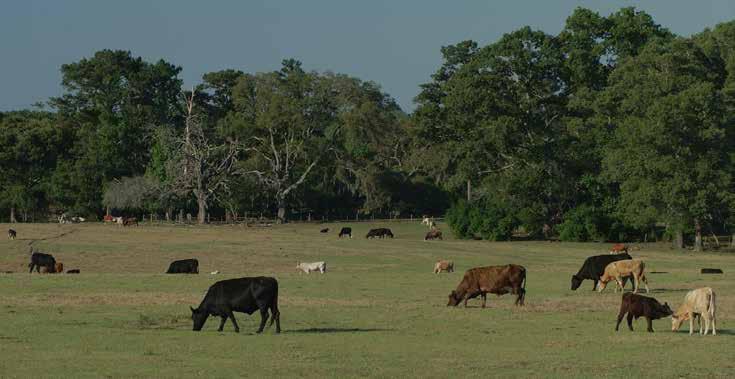

WWW.INTHEFIELDMAGAZINE.COM INTHEFIELD MAGAZINE December 2022 39 PAGE
A Closer Look
by Sean Green Naturally Amazing Activities
Pine Scented Cleaner
Many of us remember the original Pine Sol® cleaner. It was invented in 1929 by chemist Harry A. Cole and reached its height in popularity in the 1950s. Pine oil has long been used as a disinfectant, fungicide, germicide, and even virucide.
Although the clinical effectiveness of pine oil as a catchall cleaner and sanitizer remains controversial, there is little contention that the scent of pine is a pleasant one. This month we are featuring a simple project that can make good use of the pine needles you will have a surplus of at the end of December. Vinegar is a great cleaner, but most agree that its aromatic quality has a little room for improvement. We are going to try to improve that by infusing vinegar with pine by soaking pine needles in vinegar.
Supplies:
Vinegar
(apple cider vinegar recommended but not critical) Pine Needles (spruce is said to be the best)
Production:
• Cut small branches of pine needles from the pine tree

• Include not only pine needles, but also small twigs
• Stuff as many pine needles and pine twigs as you can into an empty mason jar
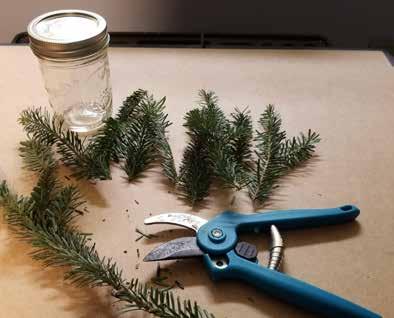
• Fill the mason jar with vinegar and let it sit for two months. The longer it sits the better it will smell.
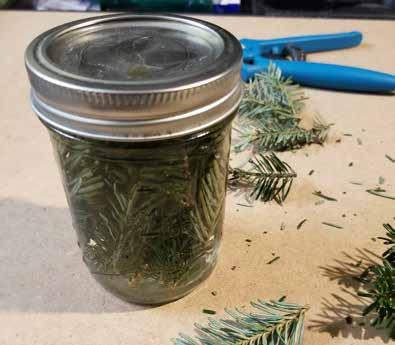
WWW.INTHEFIELDMAGAZINE.COM INTHEFIELD MAGAZINE December 2022 40 PAGE
A Closer Look by
Kudzu (Pueraria montana)
reducing soil erosion caused by such poor farming practices (deep plowing) in the South. It was during this era that the imported Kudzu (Pueraria montana) went from being a charm to a champion.
An estimated 85 million kudzu plants were distributed to southern landowners to reduce soil erosion with the added benefit of adding nitrogen to a barren soil to revitalize the land. The government paid farmers up to $8 per acre as an incentive to plant their agriculture land in Kudzu. This plant soon grew to be celebrated as a hero. Numerous kudzu clubs, kudzu festivals were formed, and kudzu queens were crowned in honor of the imported kudzu. It did not take long for this previously celebrated foreign guest to become a nuisance. In states such as Florida, the warm climate, plentiful rainfall, and long growing seasons created the perfect environment for kudzu to thrive to invasive proportions and few diseases or insect predators had populations in North America to keep the plant in check. By the early 1950s, farmlands had become abandoned to the uncontrollable spread of kudzu.
Christmas is upon us, and I hope ya’ll are enjoying some time with family and dear friends. Last month we looked at mistletoe, a parasitic but beloved plant that has become associated with Christmas. This month we are featuring a familiar invasive plant that is described as “the vine that ate the South.” Not as endearing as mistletoe, but nonetheless worthy of a closer look.
If you were raised in the South, you may have heard fables that this plant is full of breeding snakes, and that the plant itself grows a mile a minute, is impossible to stop and will eat large cities every year. When one witnesses Kudzu blanketing unmanaged roadside trees, abandoned houses and vehicles, it makes the fables seem true and supports popular misconceptions that the fables are true. The short and simple truth is that this plant was intentionally introduced to North America and has a history of our government encouraging its propagation and later realizing such encouragement was not in our best interests. While the tragic misunderstanding of the plant has resulted in terrible outcomes, the plant itself has virtue and like anything else in nature, invasive or not, environmental balance, not eradication is what we should strive for.
Kudzu was introduced to North America in 1876 as a display at the Japanese Exhibition of the Philadelphia Centennial Exposition, the first official World’s Fair. Again in 1883 at the New Orleans Exposition, and in 1893 at the Chicago World’s Fair. For 30 years the plant was regarded as an exotic ornamental plant in much the same way we regard modern imported ornamentals, beautiful and harmless. Seeds could be ordered through mail order catalogs and were imported and marketed as plants that could bring shade to the porches and courtyards of southern homes, the grapelike aroma of its flowers made the Eden created by such enclosures all the better. In addition to the popularity as a sweet-smelling ornamental, Kudzu was marketed as an inexpensive forage plant for livestock because of its rapid growth rate.
The Dust Bowl era (1930s-1940s) was in part a result of the practice of deep land in the American Great Plains, to increase the yield of certain crops such as grains, famers were told. The unintended result of the (then) popular agriculture practice was that doing so destroyed the native grasses that kept the topsoil and its water content intact. This practice led to the topsoil being devoid of any root systems that could hold the topsoil together and soil erosion became a new problem for agriculture in North America. Combined with natural draught conditions, the great dust bowl of infertile, sandy topsoil led way to local famine. Eventually the government became involved, and the Natural Resource Conservation Service was established by congress in 1933 and charged with the task of
The environmental effect of uncontrolled kudzu growth soon became apparent. General observations and reports suggested that the shading created when kudzu envelopes trees and other native plants reduces the native plant biodiversity. Kudzu will smother seedlings and saplings of younger trees and can increase the canopy density in larger older trees making them more susceptible to windthrow during storms. Controlling kudzu growth along utility lines and railroad tracks becomes increasingly expensive and failure to control such growth creates safety and service concerns. Kudzu is not susceptible to many diseases and insect pests in North America yet serves as a host for agricultural threats such as the fungus (Phakopsora pachyrhizi) that causes Asian soybean rust and the kudzu bug (Megacopta cribraria), a natural pest of kudzu that routinely migrates from kudzu to feed on soy creating an economic impact in soybean crops.
By 1953, the ecologic damage created by uncontrolled kudzu inspired the United States Department of Agriculture to ban kudzu as a permissible cover crop. By 1962 the Natural Resource Conservation Service limited its recommendation of kudzu usage to areas far removed from developed areas. In 1970, the USDA formally listed kudzu as a “common weed” in the South and it was not until 1997 that congress placed it on the Federal Noxious Weed list. Although kudzu was only regarded as “noxious” on a federal level for a few years, it remains a “noxious weed” in many states, including Florida.
Control of kudzu is difficult; mechanical control can take as much as 10 years to completely eradicate a stand of rootstock and stored nutrients. Kudzu is however a food for many animals including human beings and is considered a known “famine food.” My personal take on invasive species is for us humans to become a consumer of such species when possible. The biggest problem with us becoming the primary consumer is that is that there are many chemicals used for the control of invasive plants such as kudzu, therefore, the safety in becoming a consumer of invasives when camping, for example, is questionable. It is safer for us to assume chemicals are being used to control kudzu and do not consider consuming kudzu from the wild, especially in state and county parks and potentially state forests. Livestock can feed on kudzu as well and have the potential to be an effective biologic method of control. Kudzu is a fantastic plant to use for basket weaving, rope making, and other creative endeavors. Because this plant is not only invasive but also considered “noxious.” I will encourage you to take a closer look at this plant for its virtues and consider the benefits of harvesting unwanted stands of it. If you do so, please practice due diligence and make sure you research enough to be 100% sure of the plant’s identity.

WWW.INTHEFIELDMAGAZINE.COM INTHEFIELD MAGAZINE December 2022 41 PAGE
Sean Green
The photo is Kudzu overtaking the historic Dozier School for Boys in Marianna, FL photo credit: Upfish-Sinclair (reddit.com)
Cleanliness and temperature key to safe holiday meals

Whether you dine on a traditional holiday meal this year – or opt for something more exotic -- keep safety in mind. That starts with shopping and goes through preparing the feast and storing leftovers.
We talked to Keith Schneider, a UF/IFAS professor of food science and human nutrition and lead author of this UF/IFAS Extension document, about safety tips for holiday meals.
A: We tend to prepare larger meals for more people. This makes the potential for a foodborne mishap just a little bit bigger. No one wants to make anyone sick during the holidays. The good news: it’s easy to avoid this.
Q: As a general rule, how do you prepare and cook holiday meals safely?
A: For simple, helpful tips, you can go to the Partnership for Food Safety Education’s Fight BAC website. The four key principles of preparing a safe holiday meal are:
• Keep your kitchen and food contact surfaces clean.
• Separate foods to prevent cross-contamination.
• Cook to the proper temperature.
• Chill foods to prevent pathogen growth.
By Brad Buck
A: When we’re talking food safety, the most common area of concern is the turkey. Be careful as you unwrap the turkey. Liquid can escape, which can contain harmful microorganisms. It’s almost impossible to remove a turkey from its package and place it in a roasting pan without getting some liquid in your sink or on your countertops. Always remember to clean and sanitize the surfaces after you remove your turkey. If you buy a frozen turkey, you’re going to need to let it thaw in the refrigerator for about 24 hours for every 4 or 5 pounds of the turkey. Don’t leave a turkey on the counter for an extended period of time (for example, overnight). Remember, we’re trying to keep the temperature at or below 40 degrees to prevent pathogen growth.
Q: OK, we’ve prepared the turkey. Now, we’re going to cook it. How do we do that safely?
A: Once you’ve placed your turkey in the roasting pan and added your favorite herbs and spices, you must cook it at the proper temperature. The USDA recommends that the turkey reach an internal temperature of 165 degrees. Some turkeys come with a pop-up indicator to let you know when this temperature is reached; it is recommended that you get a calibrated food thermometer and insert it into the thickest part of the breast.
Q: What are the most common mistakes people make in holiday meal preparation?
A: In addition to not cooking the turkey properly, another
WWW.INTHEFIELDMAGAZINE.COM INTHEFIELD MAGAZINE December 2022 42 PAGE
Q: What makes holiday food safety different from everyday meals?
Q: What are the best practices for planning and shopping for a holiday meal?
typical misstep can happen when we use things like cutting boards to prepare foods intended to be cooked and then use the same cutting boards to prepare a salad. When using cutting boards, utensils, etc., either use a dedicated one or wash them thoroughly between each food prep.
Q: What are the most important guidelines for storing leftovers and eating them?

A: After two hours, foods that have been sitting out at temperatures between 40 and 140 degrees can allow potentially harmful bacteria to multiply. The temperature range between 40 and 140 degrees is known as the “danger zone.” The temperature range between 40 and 140 is known as the “danger zone.” The longer foods stay out, the higher the risk of a foodborne illness. When possible, store foods in appropriate containers and move to a refrigerator as soon as possible. Remember that the larger the storage container, the longer it takes the food to cool down. Try to limit the size of your storage containers to a height of 4 inches. When placing them in a refrigerator or freezer, allow air to circulate around each of the containers to aid in cooling.
Q: What about eggnog? Is there something specific we should know about making it safely?
A: The concern with eggnog is the use of raw eggs and their potential to carry the harmful bacteria Salmonella. If you’re going to make your own eggnog, eggs must be cooked to 160 degrees to kill any pathogens that might be present. Use liquid or pasteurized eggs. These typically can be found next to regular eggs at your grocery store. An egg substitute can also be used. These products have been pasteurized, which means that no further cooking is necessary.
ABOUT UF/IFAS
The mission of the University of Florida Institute of Food and Agricultural Sciences (UF/IFAS) is to develop knowledge relevant to agricultural, human and natural resources and to make that knowledge available to sustain and enhance the quality of human life. With more than a dozen research facilities, 67 county Extension offices, and award-winning students and faculty in the UF College of Agricultural and Life Sciences, UF/IFAS brings science-based solutions to the state’s agricultural and natural resources industries, and all Florida residents. ifas.ufl.edu | @UF_IFAS
ABOUT ‘FOOD IS OUR MIDDLE NAME’ CAMPAIGN
Feeding a hungry world takes effort. Nearly everything we do comes back to food: from growing it and getting it to consumers, to conserving natural resources and supporting agricultural efforts. Explore all the reasons why at ifas.ufl.edu/food or follow #FoodIsOurMiddleName

WWW.INTHEFIELDMAGAZINE.COM INTHEFIELD MAGAZINE December 2022 43 PAGE
Reclamation ecologists like Ashlee work to return mined lands to productive use as wildlife habitats, public parks and more—so future generations can enjoy these lands for years to come.
With every generation, we get better at protecting our environment.
®
A Field Day at UF/IFAS Indian River Research and Education Center
By Robin Koestoyo
Florida citrus producers, including corporate leaders and research scientists, gathered recently to tour a 20-acre experimental citrus grove to observe the disease tolerance and horticultural performance of more than 5,500 trees in Florida. University of Florida research scientists will carry out the first harvest of the “Millennium Block,” a citrus grove planted in 2019 to help Florida growers decide which varieties to plant. The growers need trees that produce high-quality fresh fruit with tolerance of citrus greening and diaprepes root weevil.
“Attendance at the annual field days is testimony to the interest and importance of these rootstock and scion trials to our stakeholders and fellow researchers,” said Ronald D. Cave, director of the UF/IFAS Indian River Research and Education Center (IRREC), in Fort Pierce, a 75-year-old research site at the center of the world’s renowned grapefruit production region. Cave is the lead investigator of the experiment.
Visitors from as far away as Sebring and Lake Alfred, drove through well-maintained rows of citrus trees marked with blue signs and tags coordinated with color-coded maps. Keys on the maps identified each rootstock and scion combination in replicated experimental plots.
Tom James, a UF/IFAS biological scientist at IRREC, said the grove is a good testing ground to identify the right combinations of new citrus rootstocks, the underground part of a tree, and scions, the aboveground fruit-bearing part. But he cautions that data is generally collected and analyzed for up to seven years before the researchers draw reliable scientific conclusions for the industry.
Still, interest in the ongoing observations of the trees is strong, and the anticipation of the first year of harvest data is high. There are 154 new citrus scion-rootstock combinations. Some will produce market-ready fruit. And some growers may want to make decisions based on the early data.
The grove features trials for navel oranges, mandarins, and grapefruit on numerous rootstocks, but the largest trial is for grapefruit and grapefruit-like scions, the crop in which visitors are most interested, said James.
“By years four, five, and six, we will have a much clearer understanding,” said James. The trial is now in its third year. And, the fruit they call grapefruit-like, or hybrids, produce healthful fruit that tastes good—even in mid-October.
In the grapefruit area, researchers from the UF/IFAS Citrus Research and Education Center examined the ‘UF 914’ scion, a grapefruit-like hybrid created by Professor of Horticulture and plant breeder Fred Gmitter. Gmitter explains that the fruit was developed without the chemicals that are responsible for the grapefruit-drug interactions, that discourage people taking various medications from enjoying grapefruit. “The variety potentially could be marketed to consumers to safely consume grapefruit while using blood pressure or cholesterol control medications. Large scale clinical trials would be needed, however, for U.S. Food and Drug Administration to approve labeling the fruit variety as safe for the medicationniche-market consumers,” said Gmitter.
But Gmitter prefers to focus more on the eating quality of ‘UF 914’. “At its peak its taste is superior, according to taste testers in many different locations over the years,” said Gmitter. Gmitter added he was surprised to see that it is holding up well to
greening, particularly on the X-639 rootstock. In fact, some of the best-looking trees in the trial are the ‘UF 914’-and X-639 combination.
The 914’s flesh is deep red, its rind is thick, and in the prime harvest months, February and March, the fruit is sweet and full of flavor equal to a grapefruit, said James.
“Grapefruit is susceptible to citrus greening,” said James. “The Indian River District produces premium grapefruit shipped to places worldwide, and it’s the variety growers in this area most want to grow.”
Among the rootstocks tested, sour orange rootstock was included because it is a traditional selection for the region, and some combinations with this rootstock are doing well in the grove, James said.
“The grove is in a high greening and diaprepes root weevil area,” said Pete Spyke, a longtime citrus producer and member of the IRREC Advisory Committee. Spyke advises university researchers for the work in the experimental grove.
“One of the things the researchers want is for the trees to become infected with greening at a very early age,” said Spyke. “We are not doing anything to prevent trees becoming infected with greening, just basic grove care.”
As recently as the 1970s, citrus production included only three predominant rootstocks. Cleopatra for mandarins; sour orange for fresh fruit and juice orange and grapefruit trees; and rough lemon for fruit primarily made into juice, most of which were Valencia oranges, Spyke said.
“The work put into the Millennium Block involves over 30 rootstocks,” said Spyke. “The assumption is that a few of them will eventually replace the traditional industry rootstocks. The rootstock portion of the trial is primarily designed to compare rootstocks in the UFR (‘University of Florida Rootstock’) group with other industry standard rootstocks. The Millennium Block is the most complete side-by-side UFR rootstock trial in Florida.”
Cave said the researchers will select from the experimental grove about five rootstocks that perform best in Florida citrus. The rootstocks chosen will work well in the local region but may not achieve the same in the state’s central or southwestern growing regions.
Travis Murphy, a heritage citrus grower and IRREC Advisory Committee member, said a goal of the research is to use promising plant breeding results for new varieties and UFR rootstocks that better fit the current market. They look at rootstock components that tolerate disease and produce fruit that holds high internal quality for the fresh market.
“The new varieties may also produce good fruit for juice in the old varieties as well as in new juice varieties,” said Murphy. “Plant breeding work for new rootstocks and new varieties is more important today than when we were producing 244 million boxes of oranges in 1997. We never know what we will face with new diseases and pests, so the need for continuous plant breeding work and trials is more likely to grow even larger in the future,” said Murphy.
WWW.INTHEFIELDMAGAZINE.COM INTHEFIELD MAGAZINE December 2022 44 PAGE
Are Your Bulls Breeding Season Ready?
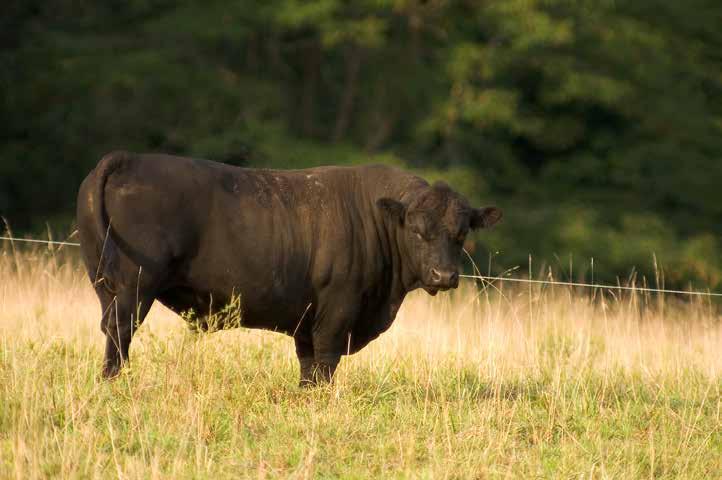
As the year ends and we gear up for breeding season, it is time to check the fertility of our bulls. We don’t want to take guesses as to whether our bulls are breeding ready, we need to make all assurances possible that they are. The herd sire contributes 50% of the genetic potential for the calf crop. One bull that doesn’t perform as expected can result in significant economic losses. Therefore, it is critical that a bull Breeding Soundness Exam (BSE) is conducted every year, 60-75 days prior to the breeding season. Breeding Soundness Exams should be conducted by a licensed veterinarian. Whether you are using your existing bull battery or purchasing new bulls, every bull must pass the Breeding Soundness Exam.
A BSE evaluates four areas:
· A physical examination of the bull. This includes the detection of unsoundness in feet, legs and eyes, etc.
· Examination of the accessory sex organs by rectal palpation.
By Maggie Fussell
· Measurement of the scrotum as well as palpation of the testis and epididymis
· Collection and microscopic evaluation of a semen sample (sperm motility and morphology).
A BSE does not evaluate a bull’s ability to breed nor his breeding behavior (such as libido). Bulls should be observed in the act of breeding to evaluate these behaviors.
In addition to a BSE, breeding bulls should also be tested for and/or vaccinated against venereal diseases. Talk to your veterinarian about tests, vaccinations, and a Breeding Soundness Exam for your herd sires. If purchasing new bulls be sure that they have passed their BSE and have been tested (even “virgin” bulls) and/or vaccinated against the diseases recommended by your veterinarian.
WWW.INTHEFIELDMAGAZINE.COM INTHEFIELD MAGAZINE December 2022 45 PAGE
BUILDING SUPPLIES
METAL ROOFING
Thousands of 8ft. & 10ft. sheets. In Stock. Prices from $6 and up. Custom lengths available. 813-752-7088 ask for Ferris.
ALUMINUM
We have all your aluminum needs! Screen Room, carports & awnings. Call Blake (813) 752-3378
WINDOW SCREENS
We make window screens of all sizes available in different frame colors. Call Ted(813) 752-3378
CABINETS
All wood kitchen cabinets. All wood vanities. Custom made to your size. Call Chris 813-752-3378
VINYL SIDING
Many colors and styles to choose from. Ask for Ted. 813-752-3378
MOBILE HOME SUPPLIES
Everything you need under ONE roof! Call Blake 813-752-3378 NEW, USED & ABUSED.
CALL FOR A WINDOW QUOTE.
We are a MI Windows dealer. Our windows are energy star, lifetime warranty. Call Broke & Poor 813-752-3378
FARM EQUIPMENT
I4 POWER EQUIPMENT
Trade-Ins Welcomed, Service Department Available. Exit 22 • S. Frontage Rd. Plant City 813-752-4459
GRIBALDI-SALVIA SB3947
Sickle bar mower. Good condition and ready to work. $1,500 Call Alvie 813-759-8722
JOHN DEERE
Looking for your new tractor? Come see us at Everglades Farm Equipment. evergladesfarmequipment.com 2805 SR 60 West, Plant City 813-737-1660
OVERSTOCK SPECIAL Barn doors starting at $80.00 Call Ted 813-752-3378
2020 MAHINDRA 6065
Tractor with loader. 491 hours, 4x4. $35,500 Call John 863-537-1345
1989 JOHN DEERE
770 2 wd tractor with 5' mid mount mower. $5,650 ask for Alvie. 813-759-8722
CITRUS PACKING HOUSE
Citrus packing house equipment for sale. Mikey Fertilizer Spreader, two wind machines. Call 863-324-2833
USED BALDOR-RELIANCE
Used 7.5 HP pump motor and 119 gal. holding-tank. Call LLCA 813-382-8382
2016 MASSEY FERGUSON
4607 TRACTOR
75hp, 4x4, cab, loader. 1950 hours in very good condition. $32,500 Call today and ask for Alvie. 813-759-8722
FOR SALE
OLD ANTIQUE BLUE STOVE
Bread warmer, chrome trim. You have got to see it to believe it! Call Ted for more details. 813-752-3378
DOORS & WINDOWS SPECIAL ORDER
No upcharge. House & Mobile Home. Many standard sizes in stock. Ask for Blake. (813) 752-3378
KITCHEN CABINETS & VANITIES
Get quality all wood cabinets for less than the BIG Box STORES! Call Today! Ask for Blake. (813) 752-3378
JOBS
MECHANIC NEEDED
Agricultural equipment. Pay with benefits based on experience. Call David 863-537-1345 or Alvie 813-759-8722
PARTS COUNTER HELP
Wanted for parts look up and sales. Experience in the agriculture equipment service. Speak with Alvie. 813-759-8722
LAWN EQUIPMENT/ SUPPLIES
USED ZERO TURN MOWERS
Prices begin at $1,750 Call Alive 813-759-8722
USED HUSQVARNA
Lawn tractor with 48" deck. Bagging system included. In good condition. $995.00 Call Alvie 813-759-8722
PRODUCE
FRESH PRODUCE
Forbes Road Produce. Open everyday from 7:30am - 8pm. Forbes Rd. & I-4 @ exit 17. Come out and see us!
MISC.
FREE Wooden Shipping Pallets All sizes! Call Alvie 813-759-8722
24 HOUR SERVICE
Coggins Plumbing licensed • bonded • Insured. www.cogginsplumbing.com 813-643-7173
FARM BUREAU INSURANCE


We have you covered! Call us today. 813-752-5577
ALAN’S AIR CONDITIONING
Residential, Commercial Sales SVS & Repair. Legendary service for over20 years! 813-752-0821
SHOWER STALLS - FIBERGLASS
Scratch and dent shower stalls - fiberglass perfect for hunting camps. $150 you pick! Call us! 813-752-3378
FOR RENT
Millcreek Pine Bark Row Mulcher. For blueberry farms, six yard, PTO drive need at least a 30hp tractor. Call 863-604-2526 for rental details.

2016 MASSEY FERGUSON 2606H
65hp, 2wd grading tractor with Bush Hog RBX780 box blade. 178 hours. $28,500 Call Avie 813-759-8722
USED SNAPPPER RIDING MOWER
42" cut. Good condition! $900.00 Ask for Alvie 813-759-8722
WWW.INTHEFIELDMAGAZINE.COM INTHEFIELD MAGAZINE December 2022 46 PAGE
TRADE • BUY • SELL? Since 2004 In The Field has been Hillsborough and Polk Countys #1 Agriculture Magazine. Call Us at 813-759-6909 to place your Ad Today!
Info@inthefieldmagazine.com
813.759.6909
Classifieds Tel:
MASSEY FERGUSON
tractor-loader-backhoe. 22.5hp, 4x4, 83 hours, warranty. Very good condition. $17,500 Call today and ask
Follow Us on Instagram @inthefieldmagazine Follow Us on Facebook @inthefieldmagazine SOLD
2021
GC1723EB
for Alvie 813-759-8722
Polk County Cattle Women
This is the time of year when most ranchers are looking forward. Looking forward to assure they are well prepared for winter. Looking forward for practices they can implement to be more productive and efficient. Looking forward to longer days and tall grass fields filled with fat cattle. This time of year is also a time when we reflect on the past, focus on making the most of the present, and plan for the future. I pray as we are neck deep in the holiday hustle and bustle you will make time to spend with the ones who mean the most and reflect on the true reason for the season.

The amazing support we received during our cake auction at the PCCA dinner in November was truly humbling! Each year we award $4,000 in college scholarships to deserving young people in our community and the generosity we receive during our fundraiser is what makes all this possible. We were honored to recognize two of our scholarship recipients at the dinner. Dustina Garcia was recognized as our PCCW 2022 Academic scholarship recipient and Alexis Hill was recognized as our 2022 UF/IFAS CALS at Plant City scholarship recipient. We are honored to play a small part in advancing the advocacy for our next generation of agriculturalists.

During November PCCW was well represented as we had many members volunteer to share beef recipes, beef literature, beef paraphernalia, and most importantly…beef samples with the public at the Jr. League of Tampa’s Holiday Gift Market. We had a great time collaborating with cattlewomen throughout the state!
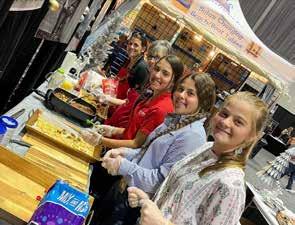
All members are invited to our Christmas shindig! If you have not received emails regarding this event, please reach out to me for more information.
On a more personal note, I would like to say what a privilege it has been to serve as PCCW President these past two years. I am deeply thankful and blessed for the amazing cattlemen and cattlewomen that have been placed in my life. I am so appreciative for the support of the PCCW membership, PCCA Board of Directors, and the PCSO Agriculture Unit for everything they have done for me these last couple of years. The words “thank you” just don’t seem adequate. Each time I needed assistance there was always someone there to lend a hand, and for that I will be forever grateful. I leave you in the very capable hands of our next president, and my daughter, Blair Buchanon who becomes the PCCW Trail Boss in January.
Speaking of January, our next meeting will be Tuesday, January 10th at 6:30 in the Valencia Room at the UF/IFAS building in Bartow. All ladies, young and experienced, are welcome to join in on all our fun and fellowship! Please reach out to me at any time for information about our events, membership, or anything in between at BuckLD96@gmail.com.
Merry Christmas to you and yours from me and mine!
Leslie Buchanon
Polk County Cattlewomen President

WWW.INTHEFIELDMAGAZINE.COM INTHEFIELD MAGAZINE December 2022 47 PAGE

WWW.INTHEFIELDMAGAZINE.COM INTHEFIELD MAGAZINE December 2022 48 PAGE






















 By Marisol Tarango
By Marisol Tarango



























































































































 Compiled by Jim Frankowiak
Compiled by Jim Frankowiak




























